An Awkward Kiss Changed How I Saw Joe Biden. “Why is the vice-president of the United States smelling my hair?”



This site is made possible by member support. ❤️
Big thanks to Arcustech for hosting the site and offering amazing tech support.
When you buy through links on kottke.org, I may earn an affiliate commission. Thanks for supporting the site!
kottke.org. home of fine hypertext products since 1998.
Entries for March 2019
Rebecca Traister: “Joe Biden Isn’t the Answer”. Seriously, this guy should not run for President. Enough already.
NYC will adopt congestion pricing in the next few years. All vehicles entering Manhattan below 60th Street will be charged a toll.
“Mr. Winston Churchill Presents His Compliments to Mr. Winston Churchill”
Before Sir Winston Churchill became a politician, he was a writer. In the late 1890s, Churchill published a pair of books about British war campaigns and continued writing throughout his life.
Around the same time, an American writer also named Winston Churchill was gaining popularity across the pond. His 1899 novel Richard Carvel sold 2 million copies and made him rich.
As the British Churchill recalled in an autobiography of his early life, around this time he reached out to his American counterpart to address the potential for their respective readers to confuse the two. In a letter dated June 7, 1899, it seems that Churchill had a bit of fun with it:
Mr. Winston Churchill presents his compliments to Mr. Winston Churchill, and begs to draw his attention to a matter which concerns them both. He has learnt from the Press notices that Mr. Winston Churchill proposes to bring out another novel, entitled Richard Carvel, which is certain to have a considerable sale both in England and America. Mr. Winston Churchill is also the author of a novel now being published in serial form in Macmillan’s Magazine, and for which he anticipates some sale both in England and America. He also proposes to publish on the 1st of October another military chronicle on the Soudan War. He has no doubt that Mr. Winston Churchill will recognise from this letter — if indeed by no other means — that there is grave danger of his works being mistaken for those of Mr. Winston Churchill. He feels sure that Mr. Winston Churchill desires this as little as he does himself. In future to avoid mistakes as far as possible, Mr. Winston Churchill has decided to sign all published articles, stories, or other work, ‘Winston Spencer Churchill’, and not ‘Winston Churchill’ as formerly. He trusts that this arrangement will commend itself to Mr. Winston Churchill, and he ventures to suggest, with a view to preventing further confusion which may arise out of this extraordinary coincidence, that both Mr. Winston Churchill and Mr. Winston Churchill should insert a short note in their respective publications explaining to the public which are the works of Mr. Winston Churchill and which those of Mr. Winston Churchill. The text of this note might form a subject for future discussion if Mr. Winston Churchill agrees with Mr. Winston Churchill’s proposition. He takes this occasion of complimenting Mr. Winston Churchill upon the style and success of his works, which are always brought to his notice whether in magazine or book form, and he trusts that Mr. Winston Churchill has derived equal pleasure from any work of his that may have attracted his attention.
The American Churchill answered back a couple of weeks later in similar fashion:
Mr. Winston Churchill is extremely grateful to Mr. Winston Churchill for bringing forward a subject which has given Mr. Winston Churchill much anxiety. Mr. Winston Churchill appreciates the courtesy of Mr. Winston Churchill in adopting the name of ‘Winston Spencer Churchill’ in his books, articles, etc. Mr. Winston Churchill makes haste to add that, had he possessed any other names, he would certainly have adopted one of them. The writings of Mr. Winston Spencer Churchill (henceforth so called) have been brought to Mr. Winston Churchill’s notice since the publication of his first story in the ‘Century’. It did not seem then to Mr. Winston Churchill that the works of Mr. Winston Spencer Churchill would conflict in any way with his own attempts at fiction.
The proposal of Mr. Winston Spencer Churchill to affix a note to the separate writings of Mr. Winston Spencer Churchill and Mr. Winston Churchill, the text of which is to be agreed on between them, — is quite acceptable to Mr. Winston Churchill. If Mr. Winston Spencer Churchill will do him the favour of drawing up this note, there is little doubt that Mr. Winston Churchill will acquiesce in its particulars.
Mr. Winston Churchill moreover, is about to ask the opinion of his friends and of his publishers as to the advisability of inserting the words ‘The American’, after his name on the title-page of his books. Should this seem wise to them, he will request his publishers to make the change in future editions.
Mr. Winston Churchill will take the liberty of sending Mr. Winston Churchill copies of the two novels he has written. He has a high admiration for the works of Mr. Winston Spencer Churchill and is looking forward with pleasure to reading Savrola.
I couldn’t find any evidence that either man ever placed a note into any of their books about the possible confusion, but their relationship was cordial. When Mr. Winston Spencer Churchill traveled to the US the next year, he was hosted by the American Mr. Winston Churchill — “He entertained me at a very gay banquet of young men, and we made each other complimentary speeches.” Nonetheless, the confusion continued: “all my mails were sent to his address and the bill for the dinner came in to me”.
Eventually, the fame of the British politician and writer eclipsed that of his American counterpart, whose books slipped from public memory when he stopped writing and withdrew from public life. Mr. Winston Spencer Churchill was awarded the Nobel Prize for Literature in 1953. (via @jackshafer)
A shorter version of this post first appeared in this morning’s Noticing newsletter. You can subscribe to Noticing right here.
Wild Stallions!
If you slip on your headphones and watch this on the biggest available screen, you may feel the unbelievable sense of freedom of running wild with a pack of horses. These white beauties are Camargue horses, “an ancient breed of horse indigenous to the Camargue area in southern France”. The white horses are semi-feral and famous for running in the ocean waves along the Mediterranean coast.
(via laura olin)
America Is Becoming Steadily Less Religious
According to new data from the General Social Survey, the number of Americans who answered “no religion” in response to the question “What is your religious tradition?” is now greater than those who identify as Catholics or evangelical Christians. Ryan Burge shared this graph of the trends from the past 50 years:

The “no religion” trend has been growing steadily since 1991. But as this piece notes, it’s tough to tell exactly why people are answering the question that way.
Even then, those who claim “no religion” are not inherently atheists or agnostics: A 2017 Pew Research survey found that only 22 percent of “nones” listed not believing in God as the most important reason for their lack of religious affiliation.
(via @heif)
What Is Our Least Useful Body Part?
Gizmodo’s Daniel Kolitz recently asked a panel of anatomists and evolutionary biologists about what the most useless part of the human body might be. Biology professor Dr. Nathan Lents reminds us that our bodies contain ample evidence of our design by evolution:
It’s hard to pick just one! The human wrist is a clunky hodgepodge of unnecessary bones. If we could design that joint from scratch, there is no way we would stick eight small, fixed, and mostly useless bones in there. We also have the stump of a tail that we could totally do without. It does nothing for us except occasionally gets injured or develops cancer.
I think my favorite useless body part is the pyramidalis muscle, which is located in our pelvic floor and attaches to the pelvis and some other connective tissue in our nether regions. What does it do? Well, when you flex this muscle, you can sort of squish the tissue in that area around pointlessly, but in monkeys and other mammals, it helps to manipulate the tail. So useless is this muscle that at least 20% of us don’t even have one and we don’t even miss it. I always enjoy telling people that, although humans and other apes don’t have tails, we still have the muscles to flex them!
Why Do Some Asian Accents Swap Ls and Rs in English?
Asian speakers switching their Rs and Ls is an old Hollywood trope that you may have seen in movies like A Christmas Story, Lethal Weapon 4, and even Lost in Translation. In this video, Joss Fong explains where that linguistic stereotype comes from and how it does and doesn’t apply to speakers of different Asian languages.
A foreign accent is when someone speaks a second language with the rules of their first language, and one of the most persistent and well-studied foreign-accent features is a lack of L/R contrast among native Japanese speakers learning English.
It’s so well-known that American soldiers in World War II reportedly used codewords like “lallapalooza” to distinguish Japanese spies from Chinese allies. But American movies and TV shows have applied this linguistic stereotype to Korean and Chinese characters too, like Kim Jong Il in Team America: World Police, or Chinese restaurant employees singing “fa ra ra ra ra” in A Christmas Story.
However, Japanese, Korean, and Chinese are completely different languages that each handle L-sound and R-sounds differently. In this episode of Vox Observatory, we take a look at each language and how it affects pronunciation for English-language learners.
See also A Phonetic Map of the Human Mouth.
The final round of the 2019 Tournament of Books is tomorrow. The matchup is Michael Ondaatje’s Warlight vs. My Sister, the Serial Killer by Oyinkan Braithwaite.
The Most Endangered Animal in Every US State



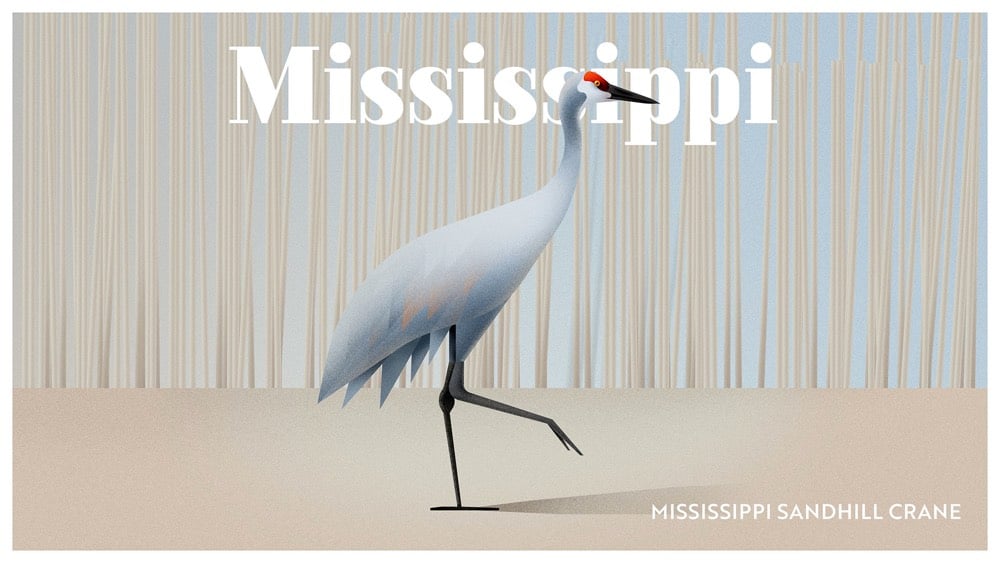

These visually striking posters showcase the most endangered animals from each of the 50 US states.
Here’s the story of the Uncompahgre fritillary butterfly from Colorado:
Colorado’s exotically-spelled native butterfly lives among snow willow patches high up in the San Juan Mountains. It has an ornate, retro look: rusty or light brown wings neatly segmented with inky black lines. Unfortunately, the Uncompahgre fritillary butterfly’s beauty has played a part in its downfall. Collectors, as well as trampling by people and livestock, have reduced their number to just 11 colonies.
We kill the things we love. (via moss and fog)
On “sober curiosity” and being more intentional about alcohol consumption and what it does to your body and life. “How different would our lives be if we stopped drinking on autopilot?”
Wall Disease - How Do Walls Affect How We Feel?
Jessica Wapner writes in the New Yorker about the research into how border walls affect the people living near them.
In the nineteen-sixties, Dietfried Müller-Hegemann wrote as though the physical presence of the Berlin Wall were itself the cause of wall disease. But most psychologists who study borders today see a more abstract relationship between those structures and mental health. Christine Leuenberger, a sociologist at Cornell University who has studied walls around the world, says that barriers are best thought of as part of a “wall system.” That system includes both physical markers, such as no-go areas and checkpoints, and ripple effects, such as job loss and the breakdown of social networks.
Leuenberger remembers meeting a Palestinian man in Bethlehem, near the West Bank barrier. He had been a nurse with a job in Jerusalem, but could no longer travel there for work. “I’m in prison in my own land,” she recalls him saying; he had resorted to selling soda by the roadside. Before the barrier, Israelis crossed the Green Line to buy produce in Palestinian towns, and Palestinians sewed fabric for Israeli textile companies. But an attempt to create a market at the border was stopped when the barrier went up. In this straightforward sense, walls can cut people off from sources of stability and happiness.
(thx, meg)
A Map of the Internet from May 1973

This is a map of ARPANET circa May 1973 via David Newbury, who found it among his father’s papers. The first part of ARPANET was built nearly 50 years ago and became the basis of the modern internet. The network was so small in the early days that those circles and squares on the 1973 map represent individual computers and routers, not universities or cities.
See also An Atlas of Cyberspaces.
The Impossibility of Translating Homer into English
Emily Wilson, who produced this banging translation of The Odyssey and is currently at work on The Iliad, recently tweeted a list of “reasons why it’s more or less impossible to translate Homer into English in a satisfactory way”. Here are a few of those reasons:
2. There aren’t enough onomatopoeic words for very loud chaotic noises.
3. “Many”, especially when repeated over and over, sounds childish; repeating “lots of” sounds worse. There are not enough words for large numbers of people or objects, and those we have (“multitude”, “plethora”, “myriad”) are often too pompous to use repeatedly.
6. Terms for social rank imply a particular wrong social order. “King” suggests monarchy. “Chief” has several connotations, none quite right. “General”, “Marshal”, “Officer” etc. suggest an established military hierarchy. “Mr” & “Sir” suggest business suits.
Last year, Wilson shared her process behind translating the first two lines of The Odyssey.
How much of Troy did he sack? ptoliethron is the lengthened form of polis, “city” (later, city-state). Sometimes =central part of city. But sacking just part of Troy isn’t really enough… Shd. the translator make it non-dumb if possible, or not worry about that?
There’s alliteration (polla/ plangthe … ptolietron epersen, notice the “p” sounds). What, if anything, should or can a translator do, when the sound of every word in her language is different from the words of the original? And, what to do about meter? Genre? Tone?
What’s the judgment, if any? Or narrative perspective? Do we feel OK about Odysseus being defined, instantly, as a city-sacker (ptoliporthos, one of his standard epithets)? Is the narrative voice invested in one side or another? It’s very hard to say. A judgment call.
And it goes on like that for more than a dozen tweets…for just two lines!
Remastering Star Trek: Deep Space Nine With Machine Learning. Promising results. Much of the series was shot on video, so remastering it in the usual way would be expensive.
Timelapse of the Future
One of my favorite Wikipedia articles is the timeline of the far future, which details the predictions science makes about the possible futures of the Earth, solar system, galaxy, and universe, from Antares exploding in a supernova visible from Earth in broad daylight in 10,000 years to the end of star formation in galaxies 1 trillion years from now…and beyond.
In his new video, Timelapse of the Future, John Boswell takes us on a trip through that timeline, a journey to the end of time.
We start in 2019 and travel exponentially through time, witnessing the future of Earth, the death of the sun, the end of all stars, proton decay, zombie galaxies, possible future civilizations, exploding black holes, the effects of dark energy, alternate universes, the final fate of the cosmos — to name a few.
A regular time lapse of that voyage would take forever, so Boswell cleverly doubles the pace every 5 seconds, so that just after 4 minutes into the video, a trillion years passes in just a second or two.1 You’d think that after the Earth is devoured by the Sun about 3 minutes in, things would get a bit boring and you could stop watching, but then you’d miss zombie white dwarfs roaming the universe in the degenerate era, the black hole mergers era 1000 trillion trillion trillion trillion years from now, the possible creation of baby “life boat” universes, and the point at which “nothing happens and it keeps not happening forever”.
This is similar to Charles and Ray Eames’ Powers of Ten increasing its speed and field of view every 10 seconds.↩
Microsoft will not participate in the tiresome internet tradition of April Fools’ Day. A good start but how about a pledge by the media to not cover AFD pranks?
The Collective Effervescence of Dancing
Why do we dance? It’s a silly question because the answer seems obvious — “because we want to, duh” — but this video from Aeon looks a bit closer at why humans like to collectively move to the beat. It has to do with our social nature and this great phrase, “collective effervescence”.
The answer, it seems, is in our need for social cohesion - that vital glue that keeps societies from breaking apart despite interpersonal differences. The French sociologist Émile Durkheim (1858-1917) theorised that ‘collective effervescence’ — moments in which people come together in some form of unifying, excitement-inducing activity — is at the root of what holds groups together. More recently, Bronwyn Tarr, an evolutionary biologist and psychologist at the University of Oxford who is also a dancer, has researched the evolutionary and neurological underpinnings of our innate tendency to bust a move. Drawing on the work of both Durkheim and Tarr, this Aeon Original video explores that unifying feeling of group ‘electricity’ that lifts us up when we’re enthralled by our favourite sports teams, participating in religious rituals, entranced by music - and, yes, dancing the night away.
You can read more about Durkheim and his work here and about Tarr’s work here.
One hypothesis is that it provides an opportunity for people to come together, making them move — dance — and in doing so we experience internal hormonal cascades which are made up of ‘feel good’ chemicals. These bursts of chemicals are part of our brain’s pain and pleasure and reward circuitry, and when they are triggered they provide an experience of elation and positive reward. When we get this kick in the presence of others, the result is that of collective joy — positive, shared experiences through which we establish and maintain important social connections with others. Now we feel like we belong to a unified, cohesive whole.
Being part of a cohesive social group would have been really important for our ancestors — collaborating with others to find shelter, hunt, rear young would have increased our chances of survival. Music and dance are by no means the only ways we can stimulate these positive social ‘highs’. But they’re really good ways of doing it because it’s an experience that we can share with lots of people at once. In order to understand why that would have given us such a great advantage we need to look at our species in the context of primates.
(via open culture)
This AI Converts Quick Sketches to Photorealistic Landscapes
NVIDIA has been doing lots of interesting things with deep learning algorithms lately (like AI-Generated Human Faces That Look Amazingly Real). Their most recent effort is the development and training of a program that takes rough sketches and converts them into realistic images.
A novice painter might set brush to canvas aiming to create a stunning sunset landscape — craggy, snow-covered peaks reflected in a glassy lake — only to end up with something that looks more like a multi-colored inkblot.
But a deep learning model developed by NVIDIA Research can do just the opposite: it turns rough doodles into photorealistic masterpieces with breathtaking ease. The tool leverages generative adversarial networks, or GANs, to convert segmentation maps into lifelike images.
Here’s a post I did 10 years ago that shows how far sketch-to-photo technology has come.
Watch Anthony Miracola make 31 NBA 3-pointers in a row in under a minute. Form’s not great but they all go right in.
The Designer’s Dictionary of Type
In his forthcoming book, The Designer’s Dictionary of Type, Sean Adams profiles 48 of the best-known typefaces in the world, from Helvetica and Garamond to Cooper Black and OCR-A. Fast Company has a short excerpt.
Cooper Black has a close association with the 1970s; however, Oswald Cooper actually created the typeface in 1921. Cooper designed the Black weight after releasing a larger Cooper Old Style family of fonts. The forms are based on old style serif typefaces but are “fat” and soft. This type of letterform gained popularity between 1910 and 1920. Other designers worked with similar forms, such as Frederic Goudy and his typefaces Goudy Heavy Face and Pabst Extra Bold. In the 1960s and 1970s, designers looking for alternatives to cold Swiss modernism and Helvetica looked back and revived Cooper Black. Its soft forms worked exceptionally well with phototypesetting, which allowed for extremely tight kerning. Both the counterculture movement and low-end DIY design adopted Cooper Black. By the end of the 1970s, the typeface was ubiquitous, but it again fell out of fashion as the New Wave movement gained momentum.
The Impossible Fractal Triangle

Nidhal Selmi combined the fractal Sierpinski triangle with the impossible Penrose triangle to create the M.C. Escher-like the Selmi triangle.
88 Important Truths I’ve Learned About Life. “Every problem you have is your responsibility, regardless of who caused it.”
Astonishingly Photorealistic Real-Time Rendered Scene By a Video Game Engine
This two-minute scene rendered in real-time by a video game engine is almost indistinguishable from real life. Petapixel explains what’s going on here:
To prepare for the project, Quixel spent a month in cold and wet locations in Iceland, scanning all kinds of objects found in the natural environment using. The team returned with over 1,000 scans that captured the details of the landscape.
Using the scans — a part of Quixel’s Megascans library — a team of three artists at Quixel created the 1:45 cinematic film in real-time using the power of the Unreal Engine 4 game engine.
Stepping Into the Uncanny, Unsettling World of Shen Yun. The near-ubiquitous dance troupe is affiliated with Falun Gong.
US Postal Service Unveils 50th Anniversary Apollo 11 Stamps
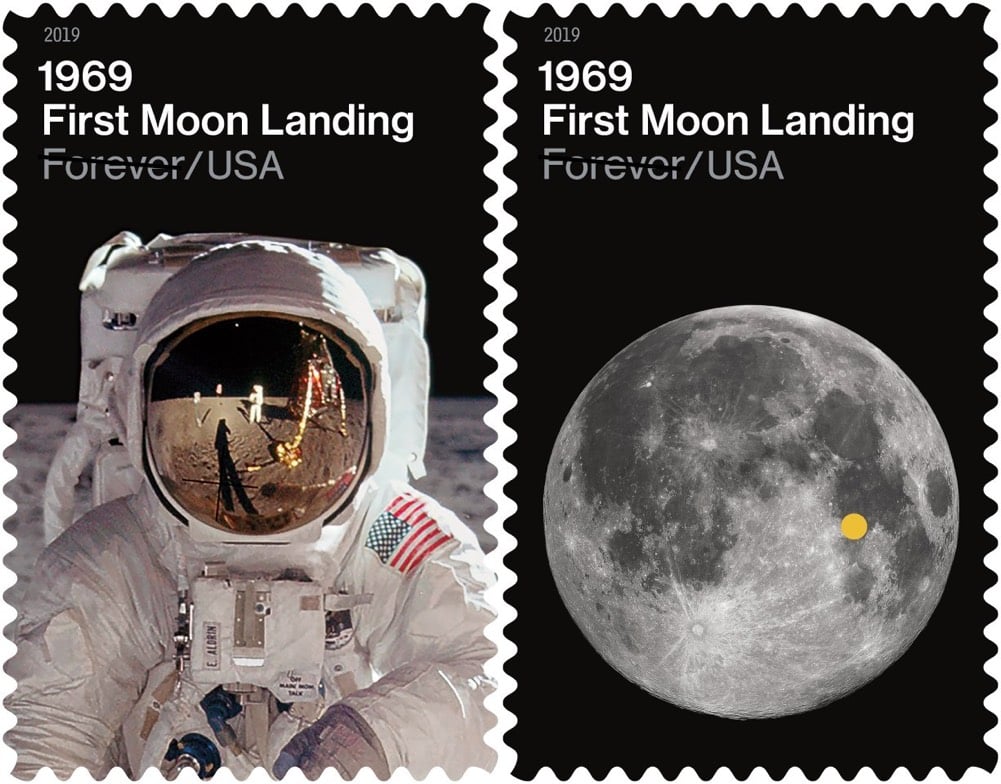
In commemoration of the 50th anniversary of the Apollo 11 Moon landing, the USPS is releasing a pair of stamps with lunar imagery.
One stamp features a photograph of Apollo 11 astronaut Buzz Aldrin in his spacesuit on the surface of the moon. The image was taken by astronaut Neil Armstrong. The other stamp, a photograph of the moon taken in 2010 by Gregory H. Revera of Huntsville, AL, shows the landing site of the lunar module in the Sea of Tranquility. The site is indicated on the stamp by a dot.
These pair nicely with the US Mint’s Apollo 11 commemorative coins.

(via swissmiss)
Ikea Hacks for People with Disabilities
Ikea furniture is so ubiquitous that all sorts of hacks and modifications have been designed by fans to coax new uses out of familiar shelves and tables. Now Ikea itself has gotten into the hacks game by partnering with a pair of Israeli non-profits to develop modifications to their products to help make them more accessible and useful for people with disabilities.
The 3D model for each of the hacks is available for free download and can then be constructed with a 3D printer. Cane By Me is a ledge for a cane or walking stick that attaches to the Malm bed frame:
Glass Bumper is a wheelchair bumper that protects the glass doors on Billy bookshelves:
Couch Lift fits around the legs of the Karlstad sofa, raising it further off the ground for easier sitting & standing:
(via fast company)
How Animators Created the Spider-Verse
2018’s most visually inventive movie was Spider-Man: Into the Spider-Verse. In this video, Danny Dimian, Visual Effects Supervisor, and Josh Beveridge, Head of Character Animation, talk about how they and their team created the look of the movie.
Two of my favorite details of the movie were the halftone patterns and the offset printing artifacts used to “blur” the backgrounds and fast-moving elements in some scenes. Borrowing those elements from the comic books could have gone wrong, it could have been super cheesy, they could have overused them in a heavy-handed way. But they totally nailed it by finding ways to use these techniques in service to the story, not just aesthetically.
Oh and the machine learning stuff? Wow. I didn’t know that sort of thing was being used in film production yet. Is this a common thing?
Update: Simon Willison did a Twitter thread that points to dozens of people who worked on Spider-Verse explaining how different bits of the film got made. What an amazing resource…kudos to Sony Animation for allowing their artists to share their process in public like this.
‘The Very Hungry Caterpillar’ Turns 50 Years Old
50 years ago last week, Eric Carle’s The Very Hungry Caterpillar was published for the first time. In a piece for The Atlantic, Ashley Fetters talked to a pair of kid lit experts about why the book remains so popular today.
Part of why both kids and parents love The Very Hungry Caterpillar is because it’s an educational book that doesn’t feel like a capital-E Educational book. Traditionally, children’s literature is a didactic genre: “It teaches something,” Martin says, “but the best children’s books teach without kids knowing that they’re learning something.” In The Very Hungry Caterpillar, she adds, “you learn the days of the week. You learn colors. You learn the fruits. You learn junk-food names. In the end, you learn a little bit about nutrition, too: If you eat a whole bunch of junk food, you’re not going to feel that great.” Yet, crucially, none of the valuable information being presented ever feels “in your face,” Martin says.
The Very Hungry Caterpillar was certainly one of my favorite books as a kid — along with Cloudy With a Chance of Meatballs, Richard Scarry’s Busy, Busy Town & Cars and Trucks and Things That Go, and the Frog & Toad books — and it was one of the first books we read to our kids. I remember very clearly loving the partial pages and the holes. Holes! In a book! Right in the middle of the page! It felt transgressive. Like, what else is possible in this world if you can do such a thing? (Also, “caterpillar” is such a satisfying word to say, both correctly and, er, less so… I still default to my childhood “callarpitter” sometimes).
The great-great granddaughter of etiquette authority Emily Post has written a book called Higher Etiquette on the dos and don’ts of enjoying cannabis. “How to tackle pot faux pas such as ‘canoed’ joints and ‘lawn-mowed’ bowls…”
Sample chapter about Uber from @monteiro’s Ruined By Design: Ayn Rand Is a Dick. “I got mine, fuck you.”
Calling All Fungi & Slime Mold Fans



On her Instagram account, Marin Mushrooms, nature photographer Alison Pollack captures the otherworldly beauty of fungi and slime molds in northern California forests. (via laura olin)
Boeing 737 Max safety features as in-app purchases. I don’t know what’s more disturbing: that Boeing charges extra for safety systems or that some airlines don’t purchase them.
The Last Days of Walter Benjamin’s Life

This Aeon essay by Giorgio van Straten, “Lost in Migration,” is excerpted from a book titled In Search of Lost Books, which explains its fascination with a book that’s fascinated many people, a manuscript carried in a briefcase by Walter Benjamin at the end of his life which has never been identified or located and probably did not survive him.
I’ve always been a little turned off by the obsession with this manuscript among Benjamin fans and readers. There’s something so shattering to me about the end of Benjamin’s life, and how he died, that it feels not just trivial, but almost profane to geek out over the imaginary contents of a book he might have left behind. I feel the same way about dead musicians. It’s all just bad news.
Luckily, though, this essay does contain a compelling and concise account of the end of Benjamin’s life.
First Benjamin fled Paris, which had been bombed and was nearly about to be invaded by the German army, for Marseilles:
Benjamin was not an old man - he was only 48 years old - even if the years weighed more heavily at the time than they do now. But he was tired and unwell (his friends called him ‘Old Benj’); he suffered from asthma, had already had one heart attack, and had always been unsuited to much physical activity, accustomed as he was to spending his time either with his books or in erudite conversation. For him, every move, every physical undertaking represented a kind of trauma, yet his vicissitudes had over the years necessitated some 28 changes of address. And in addition he was bad at coping with the mundane aspects of life, the prosaic necessities of everyday living.
Hannah Arendt repeated with reference to Benjamin remarks made by Jacques Rivière about Proust:
He died of the same inexperience that permitted him to write his works. He died of ignorance of the world, because he did not know how to make a fire or open a window.
before adding to them a remark of her own:
With a precision suggesting a sleepwalker his clumsiness invariably guided him to the very centre of a misfortune.
Now this man seemingly inept in the everyday business of living found himself having to move in the midst of war, in a country on the verge of collapse, in hopeless confusion.
From Marseilles he hoped to reach Spain, since, as a German refugee, he did not have the proper exit papers.
The next morning he was joined soon after daybreak by his travelling companions. The path they took climbed ever higher, and at times it was almost impossible to follow amid rocks and gorges. Benjamin began to feel increasingly fatigued, and he adopted a strategy to make the most of his energy: walking for 10 minutes and then resting for one, timing these intervals precisely with his pocket-watch. Ten minutes of walking and one of rest. As the path became progressively steeper, the two women and the boy were obliged to help him, since he could not manage by himself to carry the black suitcase he refused to abandon, insisting that it was more important that the manuscript inside it should reach America than that he should.
A tremendous physical effort was required, and though the group found themselves frequently on the point of giving up, they eventually reached a ridge from which vantage point the sea appeared, illuminated by the sun. Not much further off was the town of Portbou: against all odds they had made it.
Spain had changed its policy on refugees just the day before:
[A]nyone arriving ‘illegally’ would be sent back to France. For Benjamin this meant being handed over to the Germans. The only concession they obtained, on account of their exhaustion and the lateness of the hour, was to spend the night in Portbou: they would be allowed to stay in the Hotel Franca. Benjamin was given room number 3. They would be expelled the next day.
For Benjamin that day never came. He killed himself by swallowing the 15 morphine tablets he had carried with him in case his cardiac problems recurred.
This is how one of the greatest writers and thinkers of the twentieth century was lost to us, forever.
A 30th anniversary oral history of Bonnie Raitt’s fantastic “comeback” album Nick of Time. Great insights by Raitt, producer Don Was, and manager Danny Goldberg, among others.
Orson Welles as a Graphic Artist
There are so many sides to Orson Welles that one of them is bound to get overlooked. Welles was a groundbreaking screen and voice actor, screenwriter, film director, radio producer, etc., etc. He was also a remarkable visual artist, which comes through in his films but is often attributed away to his great collaborators like cinematographer Gregg Toland. Even as a child, teen, and very young man, Welles was almost ruined by the fact that everything he did, he seemed to do so much better than the people around him. He was an undiscriminating prodigy, which is a very dangerous thing to be.
A new documentary by Mark Cousins, The Eyes of Orson Welles, focuses on Welles’s output in drawing, sketching, painting. It tries to recenter visual art as an essential, not accidental part of Welles’s work, and at the same time use it as a pathway to try to understand him as a person and artist.
I haven’t seen this documentary, but I’m very excited about it. Welles is one of those figures whose genius in his work almost obscures him; any new route in is welcome. It also doesn’t feel like a typical hagiographic documentary; it feels appropriately irreverent and experimental, two things which Welles almost was.
A Map of Fairyland (c. 1920)

The Library of Congress has a remarkable digitized work in its collection titled “An anciente mappe of Fairyland : newly discovered and set forth,” by Bernard Sleigh, published in London around 1920. Here’s the high-resolution image so you can see some of the detail:

The map aims to be a nearly comprehensive atlas of the world of common English fairy tales, with a few of its own twists and turns. The accompanying guidebook lays out the map’s unique, ontological take on folktales and faerie stories, with the following introductory paragraph (with a quote from Keats’s “Ode to a Nightingale”):
Of the Land of Faerie and of the way thereto
In the Heart of every child, is hidden away a golden key which unlocks the door of a silent, clean-swept room full of changing lights and mystic shadows. There, every child that is born into the world enters at times to gaze eagerly upon the one great window, pictured with ancient legends, and glowing with many colours: amber and scarlet, lapis blues and strange greens. And it is written in many places with curious letters of silver upon black and black upon silver.
About these,
“Charmed magic casements, opening on the foam
Of perilous seas, in faery lands forlorn,”there lingers a faint, plaintive music, as of far-away organ pipes, of whispering harps, and the sighing of wind amongst the reeds. You would think, at times, it was but the droning of bees in the clover field, or the fall of surf upon some long white beach. It is always there, rising, swelling, dying away in a long, pulsing, voiceless harmony, and through the jewelled panes the light changes continually from that of a pale, cold starshine to the white glory of unclouded moons; and again to the rich warmth of an Eastern sun. Always too, there is the fragrance of enchanted winds, a breathless scent that is like the fading memory of all the flowers that have raised their glad faces to the sun, and closed them softly beneath the Evening Star.
At one time or another of its life, every child that is born of woman sets trembling fingers to open wide the flashing casements — to stand gazing, awed and silent, upon a sea and sky of gold and crimson, full of winged forms grey against its summer radiance.
It goes on like this. I hope you find it charming. (I do.)
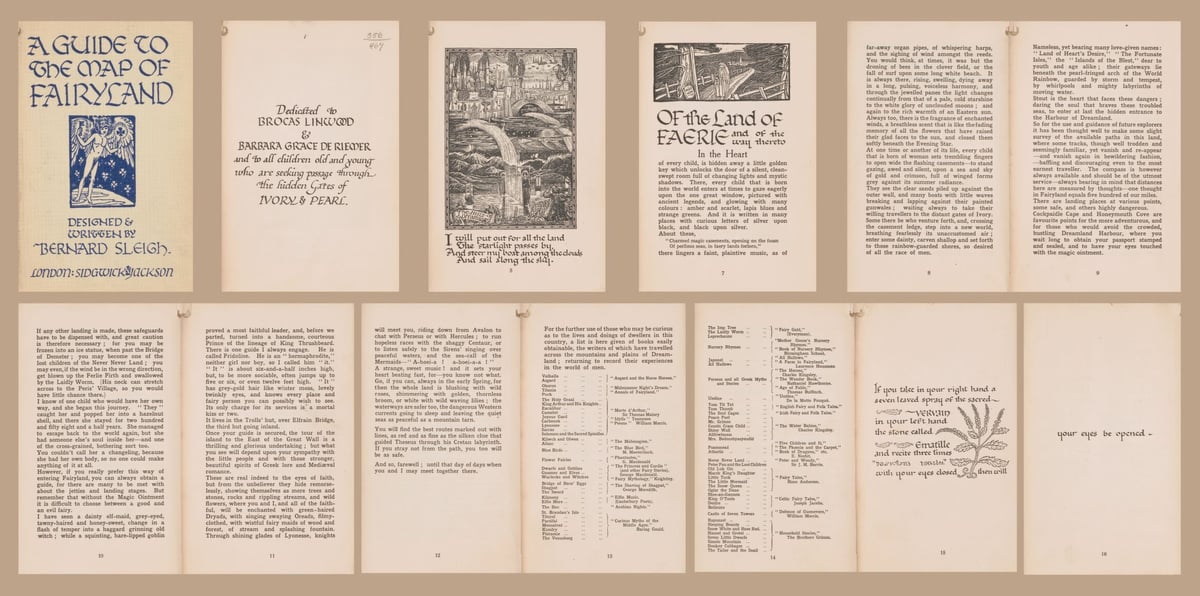
One of the many things this is useful for, besides its own right, is in understanding the cultural mentality in which works like The Lord of the Rings, CS Lewis’s writings, Walt Disney’s films, and the like were shaped. There was a real grappling with European folk stories, from the 19th century onwards, but the 20th century added a metaphysical dimension, a desire to make these stories real, to fix them in a place, to give them their own world. I find that desire fascinating, especially coming out of the horrors of World War I, and the destruction of so much of what had been the old Europe.
A Phonetic Map of the Human Mouth
This infographic from Language Base Camp shows where the sounds that English speakers use are produced in the mouth and throat.

I’ve had zero voice training in my life, so it was really illuminating to speak all of the different sounds while paying close attention to where in my mouth they were happening. Try it!
Update: And after pronouncing the sounds yourself, take a few minutes to play around with Pink Trombone. Fun! (via @pixelcult)
Emilia Clarke, who plays Daenerys Targaryen on Game of Thrones, writes about a harrowing pair of aneurysms she suffered soon after she started on the show. “At some level, I knew what was happening: my brain was damaged.”
The trailer for The Last Black Man in San Francisco. This is Joe Talbot’s feature-length debut for which he won best director at Sundance.
The Global Architect Card says in 14 different languages: “I am an architect. I am here to see this significant building.” You show it to building staff who are not used to dealing with curious “foreigners with funky glasses”.
How Ian McKellen Acts With His Eyes
In the latest episode of Nerdwriter, Evan Puschak examines how Ian McKellen does a lot of heavy lifting with his eyes, especially in the Lord of the Rings trilogy. On his way there, I really liked Puschak’s lovely description of the physical craft of acting:
Part of that craft is understanding and gaining control of all the involuntary things we do when we communicate — the inflection of the voice, the gestures of the body, and the expressions of the face.
P.S. Speaking of actors being able to control their faces, have you ever seen Jim Carrey do wordless impressions of other actors? Check this out:
The Jack Nicholson is impressive enough but his Clint Eastwood (at ~1:15) is really off the charts. Look at how many different parts of his face are moving independently from each other as that jiggling Jello mold eventually gather into Eastwood’s grimace. Both McKellen and Carrey are athletic af in terms of their body control in front of an audience or camera.
Deadwood: The Movie
Open the canned peaches because Al Swearengen, Seth Bullock, and the rest of your Deadwood favorites are back on May 31 in Deadwood: The Movie. Here’s a tease:
Swearengen: You ever think, Bullock, of not going straight at a thing?
…
Bullock: No.
I’m in 1000%. For more on the movie’s action/plot, read Tim’s post from December.
From Emily Wilson, a pronunciation guide to some of the place and character names in The Odyssey. I was pronouncing Telemachus incorrectly for at least half the book.
What’s Eating Dan?
From America’s Test Kitchen and Dan Souza, the editor-in-chief of Cook’s Illustrated, a YouTube series called What’s Eating Dan? In each episode, Souza picks a different food — pizza, rice, salmon — shares some of the science involved, and then shows us the best way to cook it. For starters, I’d suggest the first episode on burgers and a more recent one on mushrooms:
Kinetic Alphabet
From London motion design studio Mr. Kaplin, an animated alphabet where the animation for each letter is a experiment that was completed in a single day.
See also The ABCs in Motion.
Actually, Mercury Is Our Closest Planetary Neighbor
If you look at the orbits of the planets adjacent to the Earth’s orbit (Venus & Mars), you’ll see that Venus’s orbit is closest to our own. That is, at its closest approach, Venus gets closer to Earth than any other planet. But what about the average distance?
According to this article in Physics Today by Tom Stockman, Gabriel Monroe, and Samuel Cordner, if you run a simulation and do a proper calculation, you’ll find that Mercury, and not Venus or Mars, is Earth’s closest neighbor on average (and spends more time as Earth’s closest neighbor than any other planet):
Although it feels intuitive that the average distance between every point on two concentric ellipses would be the difference in their radii, in reality that difference determines only the average distance of the ellipses’ closest points. Indeed, when Earth and Venus are at their closest approach, their separation is roughly 0.28 AU — no other planet gets nearer to Earth. But just as often, the two planets are at their most distant, when Venus is on the side of the Sun opposite Earth, 1.72 AU away. We can improve the flawed calculation by averaging the distances of closest and farthest approach (resulting in an average distance of 1 AU between Earth and Venus), but finding the true solution requires a bit more effort.
What the calculation also shows is that Mercury is the closest planetary neighbor to every planet, on average. Also, the authors of the paper don’t explicitly mention this, but the Sun (at 1 AU) is closer on average to the Earth than even Mercury (1.04 AU).
Beautiful Hand-Colored Photographs of Flowers from 19th-Century Japan


From The Public Domain Review, Ogawa Kazumasa’s Hand-Coloured Photographs of Flowers.
The stunning floral images featured here are the work of Ogawa Kazumasa, a Japanese photographer, printer, and publisher known for his pioneering work in photomechanical printing and photography in the Meiji era.
A reprinted book containing these images by Kazumasa is available as are prints. (via @john_overholt)
Brilliant Papercraft Typographic Creations


Paper artist Alia Bright combines papercraft and typography to make these colorful, um, sculptures? Texts? They’re super-cool, whatever you call them. Here’s a close-up of one of the pieces, all made by hand of course:

You can keep up with Bright’s newest work on Instagram. (via swissmiss)
The Wasabi Farmer
By some accounts, 99% of the wasabi consumed in the world is not actually wasabi — it’s horseradish + green food coloring. Real wasabi is difficult to grow:
Authentic wasabi, known as Wasabia japonica, is the most expensive crop to grow in the world. The temperamental semiaquatic herb, native to the mountain streams of central Japan, is notoriously difficult to cultivate. Once planted, it takes several years to harvest; even then, it doesn’t germinate unless conditions are perfect. Grated wasabi root loses its flavor within 15 minutes.
Profiled in the short film above, 75-year old Shigeo Iida is the 8th generation owner of a wasabi farm in Japan, where he’s been painstakingly growing the herb in a beautiful valley for decades. He loves his work, but like other aging Japanese responsible for long-lived family businesses, there’s uncertainty about the future. (via craig mod)
The trailer for Stranger Things season 3. Man, this show does 80s nostalgia so so well. Not what the 80s were actually like but what they felt like (from the vantage point of 30 years later).
Quentin Tarantino’s Once Upon a Time in Hollywood
Quentin Tarantino brings back two of his biggest stars, Brad Pitt and Leonardo DiCaprio, in his new film Once Upon a Time in Hollywood. The teaser trailer is low on details, but we do know that Pitt plays stunt double to DiCaprio’s aging film star, the plot involves the murder of Sharon Tate by members of the Manson Family, and it opens on July 26. The film is also the last movie that Luke Perry made before he died.
Update: The full-length trailer is out:
Ancient History Family Trees Poster, “a wallchart displaying the genealogy of Ancient Egypt, Assyria, Persia, Greece, Rome, India, China, and more”. It’s by Matt Baker, who did the viral Evolution of the Alphabet chart.
Vibrant Oil Paintings of Clouds


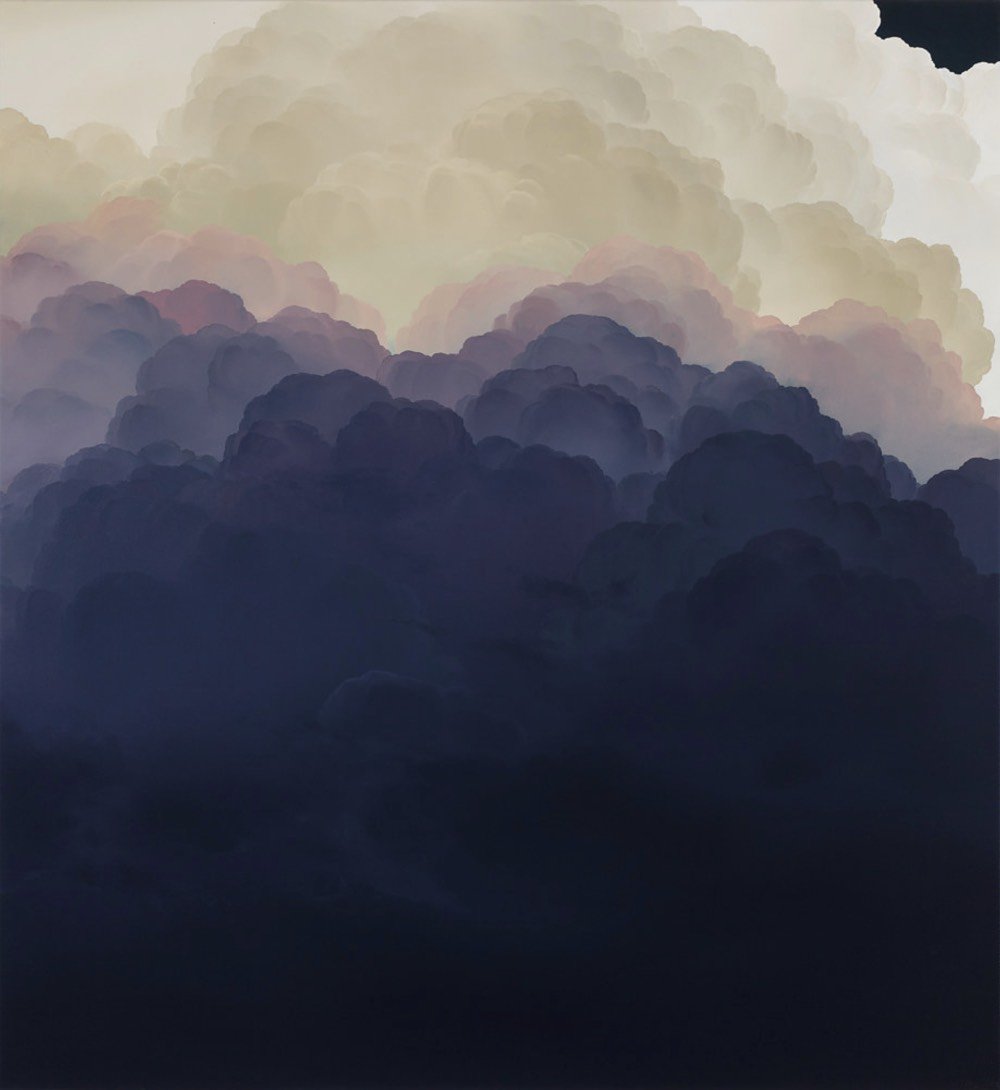
Ian Fisher’s paintings of clouds are surprisingly lifelike. If you scroll through the paintings on his site, you can see his representation of them improve…his most recent ones are difficult to distinguish from photographs of actual clouds.
A site of “endlessly unique ambient music”. Each piece is generated using a unique system and played infinitely without repetition.
The Legend of Nixon, a Data-Driven NES Soundscape
Brian Chirls took the approval ratings for Richard Nixon’s presidency and using sounds from The Legend of Zelda’s classic Dungeon Theme, he made a data-driven soundscape of the public perception of Nixon’s tenure in the White House. Here’s what his approval rating looked like:
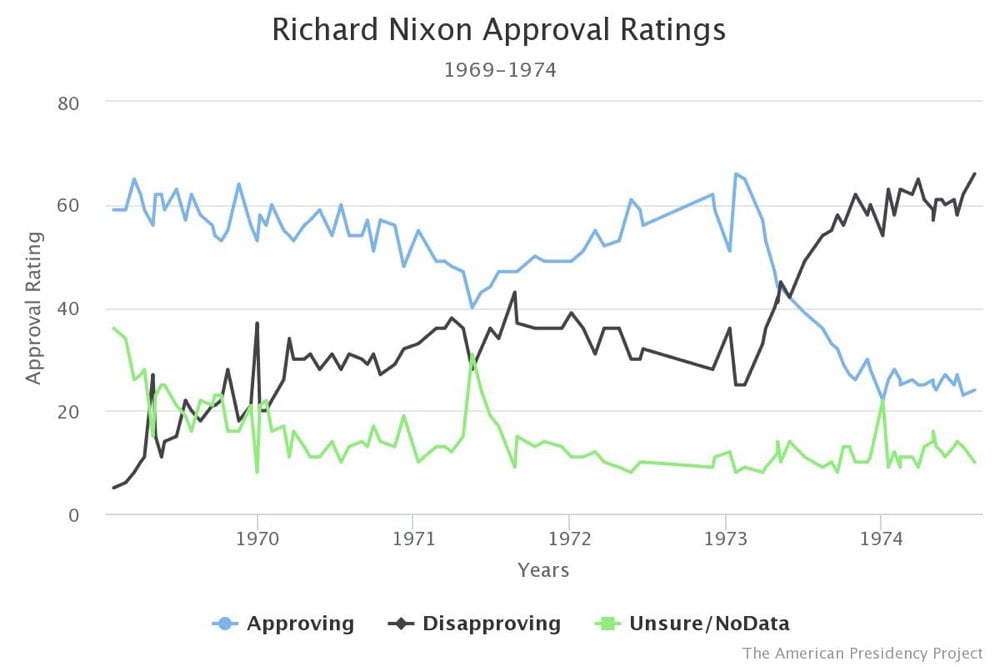
And here’s the resulting audio track:
The sound effects mostly represent actions the protagonist Link takes like the “sword slash”, things that happen to him like a grunt when he gets hurt, or the status of the game like the low health alarm that beeps when Link has only half a “heart container” left and can only take one or two more hits before he dies and the game is over. The goal of this project is to create a piece of audio that sounds like a typical playthrough of the game and also accurately tells the story of Nixon’s fall as represented by the data.
What a cool example of using the familiar to explain or illustrate the unfamiliar. If you’ve ever played Zelda, you can clearly hear Nixon doing more and more poorly as the track goes on — he’s taking damage, the dungeon boss sound chimes in right around when Watergate is ramping up, and he’s gaining fewer hearts. It’s like he’s a novice player armed only with the wooden sword trying to defeat the level 3 dungeon without a potion…the end comes pretty quickly.
A Huge Collection of Apollo 11 Press Kits
When Apollo 11 landed two men on the Moon and returned them safely to Earth, thousands of people at NASA were joined in the effort by dozens of companies that did everything from building the spacecraft to providing the cameras for the mission. Each of those companies was understandably proud of their involvement and wanted to use the mission to drum up interest in their products and services. Marketing strategist David Meerman Scott has been collecting the press kits produced by the Apollo contractors and has made them available online for free download in PDF format.
What a trove! Here are a few of my favorites. First is the kit from Fisher, who provided the pens that Armstrong, Aldrin, and Collins wrote with during the voyage.
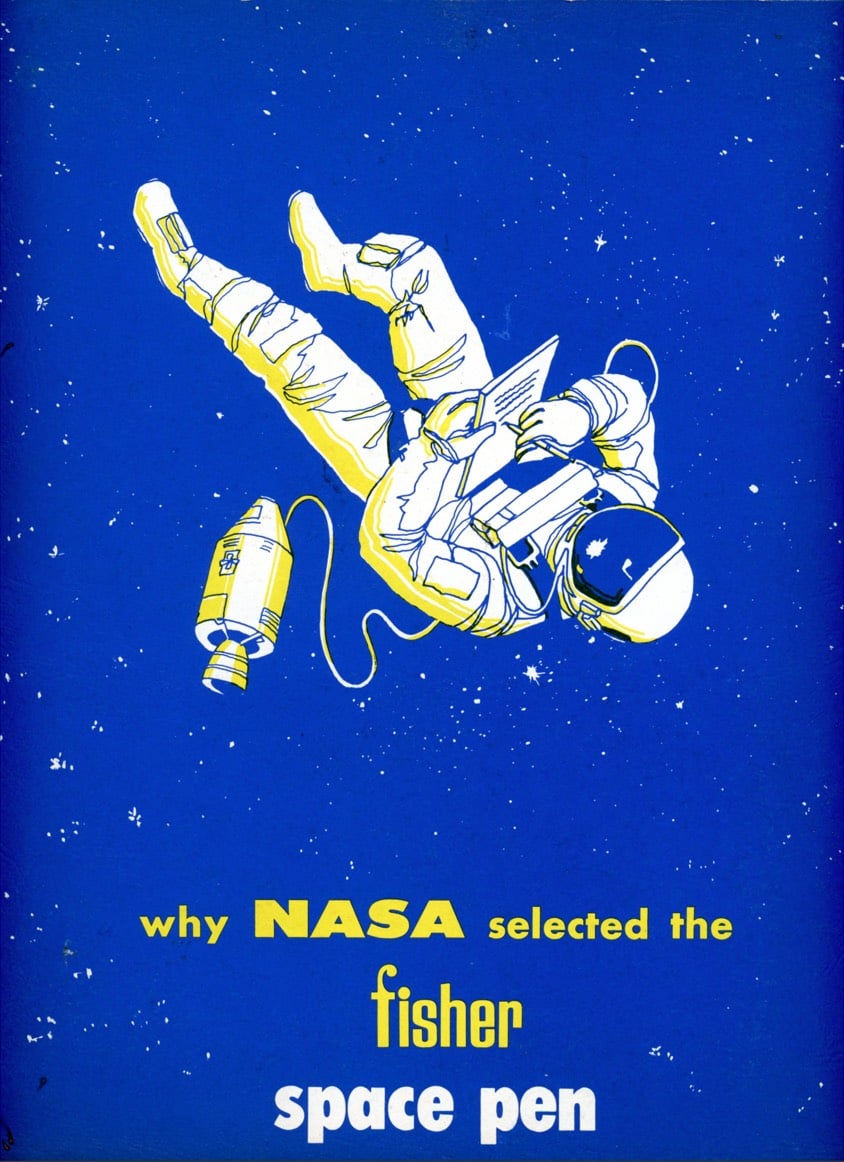
The final requirement was to see if the pen could still write after all that torture. NASA required that each pen write 1,653 feet of continuous traces, or for about 4 1/2 hours. The three pens were placed in an automatic writing machine and far out passed the qualifications. The first pen wrote for 54 hours and 50 minutes and 15,346 feet. The second finished after 18,303 feet. The third, writing on a new, highly absorbent paper, still wrote for 7,484 feet.
Fisher still sells a version of the original Apollo 11 space pen.
After the astronauts came back from the Moon, they were quarantined for 21 days to ensure that the crew had not returned with any harmful Moon germs. Stouffer’s, the frozen foods company, was contracted by NASA to provide some of the astronauts’ meals in quarantine.

A typical astronaut dinner will consist of short ribs of beef, potatoes au gratin and tossed green salad. Stouffer’s has been selected to provide from its retail line a major portion of the entrees and side dishes for the astronauts. Ease of preparation, purity, quality and variety as well as taste and appearance were the main reasons for NASA’s selection of Stouffer’s foods.
Hasselblad provided the cameras for the mission.
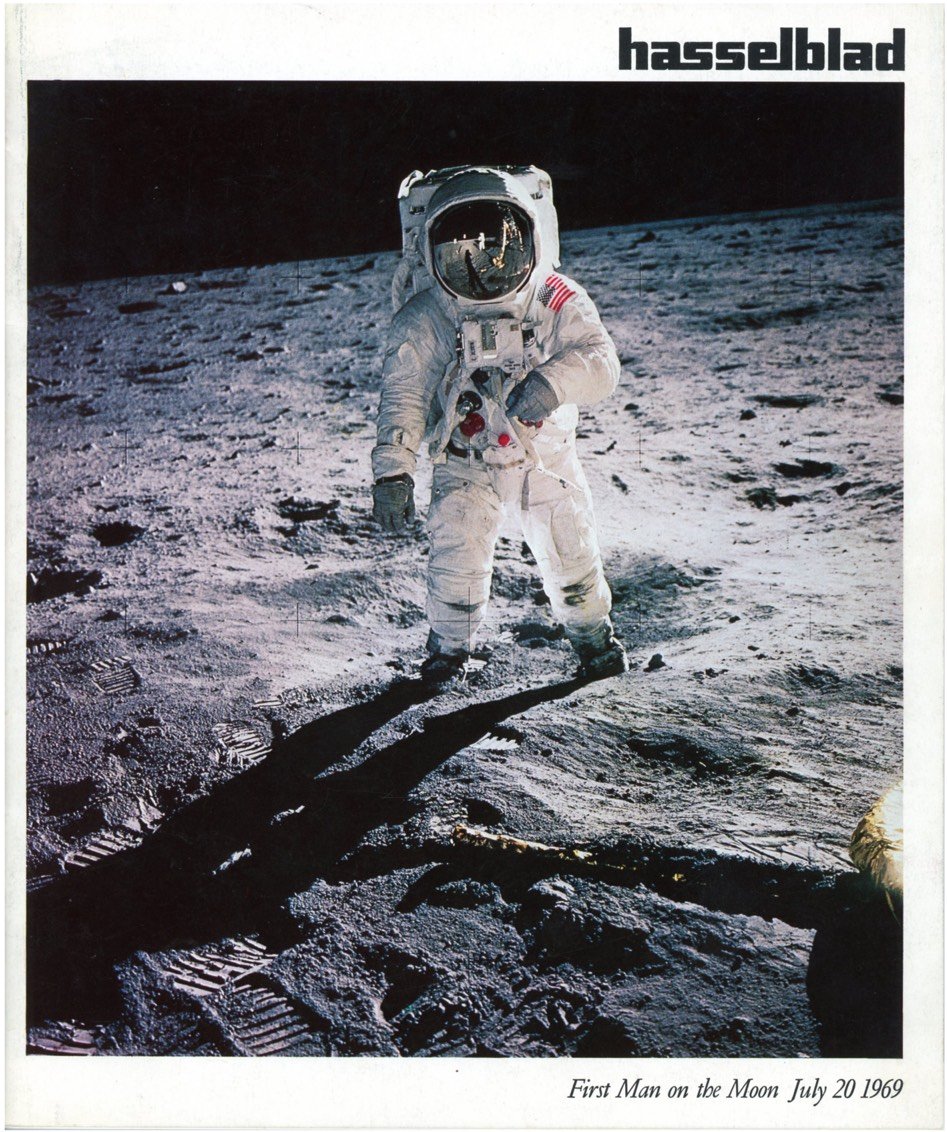
Grumman made the Lunar Module, the capsule that carried Armstrong and Aldrin to and from the surface of the Moon.
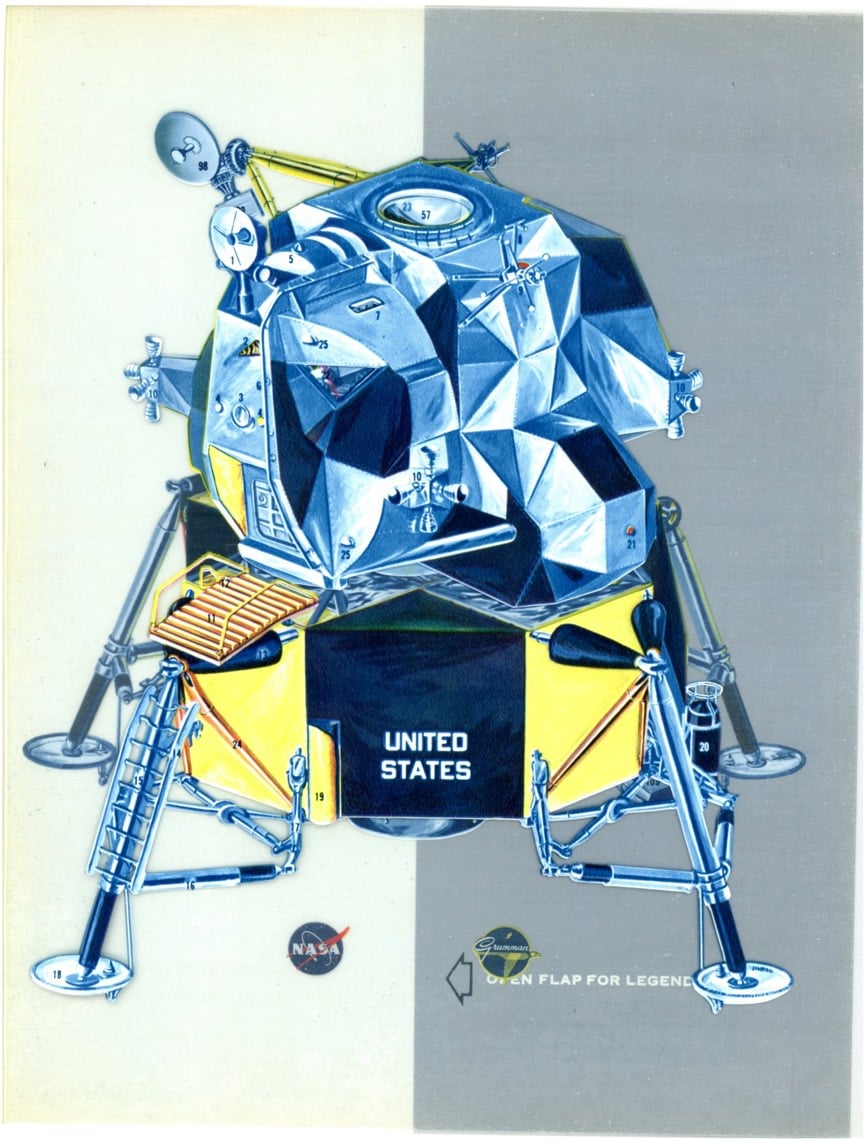
I could keep going on these all day. What a terrific resource. Scott, along with Richard Jurek, is also the author of Marketing the Moon, a book about how NASA sold the Apollo program to the American public. (via steven heller)
Cutting Commentary on News Media’s Complicity in Spreading Hateful Views
Kate McCartney and Kate McLennan, a pair of comedians whose hilarious cooking show I’ve previously featured, are back with Get Krack!n, a series that parodies a typical TV morning show. In this clip, they debut a new segment that perfectly skewers how TV media provides a platform for radical kooks to promote hateful agendas for the mutual benefit of both kook & show. (Note: this clip contains swearing and simulated religious bigotry & misogyny.)
Kheck out our brand new seggment! #getkrackin @Mrdavidquirk @chookfish @gw_deb @ABCTV pic.twitter.com/fTvrmK7tc6
— Get Krack!n (@getkrackinshow) March 7, 2019
They’re not necessarily views that we endorse or share personally, Kate McCartney, but they’re definitely opinions that we are 100% complicit in broadcasting, and that in time we will go to hell for.
This is an Australian show, but a similar panel and topic could easily have appeared on any number of Fox News programs.
According to a survey, “nearly 60 percent of people who have filed for bankruptcy said a medical expense…contributed to their bankruptcy”. Lack of guaranteed healthcare is an anchor on our national well-being.
Monica Lewinsky on Public Shaming
This week, Last Week Tonight covered the topic of public shaming and the episode included an interview by host John Oliver of Monica Lewinsky, who shared her experience of going through perhaps the most intense and enduring instance of public shaming ever.
The whole video is worth watching, but if you want to skip to the Lewinsky interview, it starts around the 15:00 mark. Lewinsky doesn’t do a lot of interviews, and it’s interesting that Oliver has built enough trust to get one, especially as the host of a comedy show.
Where Did Consciousness Come From?
Religion and philosophy have their own answers as to where our consciousness comes from, but in this video, Kurzgesagt explores how scientists believe consciousness first evolved, from organisms moving more quickly when consuming food to animals being able to animals who can remember where they hid food to reading the minds of competitors and allies.
The main source for the video is Rupert Glasgow’s Minimal Selfhood and the Origins of Consciousness (available as a free download). The complete list of their sources is here.
The Fertility Doctor’s Secret
For The Atlantic, Sarah Zhang tells the story of dozens of people who found out through DNA testing that a fertility doctor named Donald Cline had used his own sperm in artificial insemination procedures on their mothers. The piece begins with the story of a woman whose parents had been treated by Cline more than 30 years ago.
It was only when she got home and replaced her phone that she saw the barrage of messages from even more half siblings. They had found her on Facebook, she realized, after searching for the username linked to her Ancestry.com account. Her husband had given her a DNA test for Christmas because she was interested in genealogy. Her heritage turned out to be exactly what she had thought — Scottish, with English, Irish, and Scandinavian mixed in — and she never bothered to click on the link that would show whether anyone on the site shared her DNA.
Apparently she did have relatives on Ancestry.com — and not just distant cousins. The people now sending her messages said they were Cline’s secret biological children. They said their parents had also been treated by Cline. They said that decades ago, without ever telling his patients, Cline had used his own sperm to impregnate women who came to him for artificial insemination.
According to her DNA, Woock, too, was one of his children.
In the time since Woock’s half siblings got in touch with her, they have broken the news dozens more times. The children Cline fathered with his patients now number at least 48, confirmed by DNA tests from 23andMe or Ancestry.com. (Several have a twin or other siblings who likely share the same biological father but haven’t been tested.) They keep in touch through a Facebook group. New siblings pop up in waves, timed perversely after holidays like Christmas or Mother’s Day or Father’s Day, when DNA tests are given as well-intentioned gifts.
One of Cline’s patients said recently: “I feel like I was raped 15 times.”
New book by @monteiro –> Ruined by Design: How Designers Destroyed the World, and What We Can Do to Fix It. I heard Mike do a talk on this 5 years ago and he blew the doors off the place.
Everything Is Just a Happening
This guided meditation by Alan Watts really helped me this morning. (There’s a version without music as well.)
From The Practice of Meditation:
Simply sit down, close your eyes, and listen to all sounds that may be going on — without trying to name or identify them. Listen as you would listen to music. If you find that verbal thinking will not drop away, don’t attempt to stop it by force of will-power. Just keep your tongue relaxed, floating easily in the lower jaw, and listen to your thoughts as if they were birds chattering outside — mere noise in the skull — and they will eventually subside of themselves, as a turbulent and muddy pool will become calm and clear if left alone.
Also, become aware of breathing and allow your lungs to work in whatever rhythm seems congenial to them. And for a while just sit listening and feeling breath. But, if possible, don’t call it that. Simply experience the non-verbal happening. You may object that this is not “spiritual” meditation but mere attention to the “physical” world, but it should be understood that the spiritual and the physical are only ideas, philosophical conceptions, and that the reality of which you are now aware is not an idea. Furthermore, there is no “you” aware of it. That was also just an idea. Can you hear yourself listening?
And then begin to let your breath “fall” out, slowly and easily. Don’t force or strain your lungs, but let the breath come out in the same way that you let yourself slump into a comfortable bed. Simply let it go, go, and go. As soon as there is the least strain, just let it come back in as a reflex; don’t pull it in. Forget the clock. Forget to count. Just keep it up for so long as you feel the luxury of it.
(via open culture)
The Problem of Writing and Money

Now this is a lede:
When I first read Virginia Woolf’s dictum that “A woman must have money and a room of her own if she is to write fiction,” I was homeless.
It follows through on that first punch:
I know half a dozen published authors who’ve had to rely on food stamps. The seedy poverty of the author has been a cliche for centuries. We find the figure of the poor writer already in the medieval era, in the form of poet-clerics called “goliards,” who begged and sang ribald songs in taverns as they wandered from monastery to monastery. Hundreds of years later, in the Beat Generation, the type survived with no essential change. Now a new generation of writers are confronting ever lower and less reliable payment for articles, stingier advances for books, fewer jobs, and smaller royalty checks. A host of new threats to writers’ livelihoods, from internet piracy to the slow-motion collapse of the academic job market, means ever fewer writers are making a middle-class wage.
So, full-disclosure time! I have been on food stamps, as recently as a couple of years ago. I am currently on Medicaid, and thank god for that, because the open market for health care is terrible, and Medicaid is great. (Freelancers, stop paying COBRA or Obamacare and get yourself on Medicaid if you can.)
I have been a professional writer for almost ten years and have only been employed at a full-time job with benefits for (counts fingers) let’s say three of them. The rest of the time, I’ve been on the 1099 economy, piecing together pieces of living from freelance gigs. I have been homeless, and I have lived with family who’ve been much more stable than I have been. My health has never been good, which has made it difficult for me to maintain full-time work when I’ve had it. I have been behind on my child support, but am currently (thank God) current.
I would not say I am devoted to writing, with my poverty a consequence of that devotion. This entire time, I have simply not known what else to do. I have been writing for my life.
There are a lot of us. We don’t always show it.
Most writers I know who’ve been really poor practice similar forms of self-censorship. Sometimes the reasons are obvious even to someone who’s never had money problems. One writer I know went through a patch where he had to report to a subway cleaning crew to keep getting his welfare checks. He talked about this openly to friends, but went through extreme contortions to hide it from a publisher who was considering hiring him. When I was first profiled for a women’s magazine, I had their photographer come to my apartment, only to have her look around and instantly suggest we go out to a park. After that, I had photographers meet me at a richer person’s apartment to save everyone time and embarrassment.
But often the decisions are less clear-cut. Social media, for instance, can be the ideal forum for openly discussing social class—but it’s also notoriously a place where going too far can damage your career. Most of us filter what we say. This affects how we talk about being broke. A post about student debt is safe, but one about living in your car risks losing face and professional standing. It can even come across as a passive-aggressive jab at more affluent people. One writer friend of mine commented: “On Twitter, we make jokes about being poor. We don’t talk about the fucking dread eating through us because we’ll never be stable. We don’t talk about what it means, that we’re on Twitter because we can’t afford therapy or social lives.”
I don’t know what to do about any of this. I can’t promise that I’ll be more forthcoming about this on Twitter, or here on Kottke.org, or anywhere else I write. I do know that my life is changing again, thanks in part to The Amazon Chronicles, and other opportunities coming into my life. I hope it continues to change. I hope it changes for all of us.
I can only testify, right here and now, that poverty and authorship coincide, including authorship that comes with a kind of modest fame. I can testify that there is nothing romantic about it, only the very real life of compromises that Sandra Newman documents so well in this essay. I can testify that talking about and not talking about it can both eat away at you. There is no cure; only doing better and doing worse, only new wounds and a moderate form of relief.
I disagree with Newman on one point. I think there is no real market for stories about poverty, first-person or otherwise. Not really. Maybe in fiction, maybe as a one-off. But one cannot be a writer about poverty in the same way that one can become a writer about technology; and in most cases, being a writer about technology is extremely difficult when one is poor. (You can track my poverty level through my writing subjects: when I’ve done better, I write about gadgets and the business of technology. When I’ve done worse, I write about memoir or pop culture: music, movies, television, comics, the internet. Things accessible from my memory or on my computer for free or cheap.)
People may want to read about what it’s like to be poor, but they don’t want to pay for it. Paying for things is a rich person’s privilege, and people pay for access to material wealth and things that get them closer to it. And in the free economy, people like the lingua franca of pop culture. Simple stories about heroes and villains, that when you scratch them open, tell them bigger stories about themselves and the worlds they live in.
That’s not to say that people can’t be brought to hear a different kind of story, but they do have to be brought there. How to bring them there? That’s what we’re all trying to figure out.
A Fan-Made Trailer for The Fresh Prince of Bel-Air, 2019 Edition
This trailer made by cinematographer and director Morgan Cooper imagines a contemporary reboot of The Fresh Prince of Bel-Air that’s a little darker and grittier than the original. I dunno about you, but that’s one of the best fan-made trailers I’ve ever seen. I say give Cooper the show and let him run with it.
Tetanus Has Nothing To Do With Rust
Tetanus, popularly called “lockjaw,” is a serious illness, fatal in 10 percent of cases in North America and a larger percentage elsewhere. But despite the popular perception of its association with cutting oneself on a rusty nail, the disease has nothing to do with iron oxide, or rust:
Rather, tetanus is a product of the bacteria Clostridium tetani, which is in dirt, dust, and feces—in other words, everywhere. It can enter your body through puncture wounds, yes, but also through superficial cuts, bug bites, surgical procedures, and any other rupture to your skin. It can come from stepping on a rusty nail, or tending the soil in your garden. That’s why it’s so essential to track your booster shots: You need one every decade, not just when you rip your palm open on a rusty chain link fence. Waiting for a classic tetanus injury won’t work when anything could, in theory, be a tetanus injury.
If the bacteria enter your body and you aren’t up-to-date on your vaccinations, the tiny invaders begin to multiply rapidly. This incubation period, which lasts between three and 21 days, according to the CDC, is symptom free. But as the bacteria begin to die inside you, they form a neurotoxin that attacks the nervous system. Specifically, it inhibits the chemical GABA, which regulates muscle contractions. The result is a body-wide state of tension, from lockjaw in your face to uncontrollable arching spasms in your back to permanently-curled toes.
Luckily, here as elsewhere, tetanus vaccines (a series of three shots and a booster every ten years) work. Get those shots up to date and mind those cuts, no matter where they came from.
What Counts As Evidence in Mathematics?

The ultimate form of argument, and for some, the most absolute form of truth, is mathematical proof. But short of a conclusive proof of a theorem, mathematicians also consider evidence that might 1) disprove a thesis or 2) suggest its possible truth or even avenues for proving that it’s true. But in a not-quite-empirical field, what the heck counts as evidence?
The twin primes conjecture is one example where evidence, as much as proof, guides our mathematical thinking. Twin primes are pairs of prime numbers that differ by 2 — for example, 3 and 5, 11 and 13, and 101 and 103 are all twin prime pairs. The twin primes conjecture hypothesizes that there is no largest pair of twin primes, that the pairs keep appearing as we make our way toward infinity on the number line.
The twin primes conjecture is not the Twin Primes Theorem, because, despite being one of the most famous problems in number theory, no one has been able to prove it. Yet almost everyone believes it is true, because there is lots of evidence that supports it.
For example, as we search for large primes, we continue to find extremely large twin prime pairs. The largest currently known pair of twin primes have nearly 400,000 digits each. And results similar to the twin primes conjecture have been proved. In 2013, Yitang Zhang shocked the mathematical world by proving that there are infinitely many prime number pairs that differ by 70 million or less. Thanks to a subsequent public “Polymath” project, we now know that there are infinitely many pairs of primes that differ by no more than 246. We still haven’t proved that there are infinitely many pairs of primes that differ by 2 — the twin primes conjecture — but 2 is a lot closer to 246 than it is to infinity.
This starts to get really complicated once you leave the relatively straightforward arithmetical world of prime numbers behind, with its clearly empirical pairs and approximating conjectures, and start working with computer models that generate arbitrarily large numbers of mathematical statements, all of which can be counted as evidence.
Patrick Hanner, the author of this article, gives what seems like a simple example: are all lines parallel or intersecting? Then he shows how the models one can use to answer this question vary wildly based on their initial assumptions, in this case, whether one is considering lines in a single geometric plane or lines in an n-dimensional geometric space. As always in mathematics, it comes back to one’s initial set of assumptions; you can “prove” (i.e., provide large quantities of evidence for) a statement with one set of rules, but that set of rules is not the universe.
This Photo of Farmers Contains No Farmers
This is a photo taken in Germany in 1914 by August Sander:
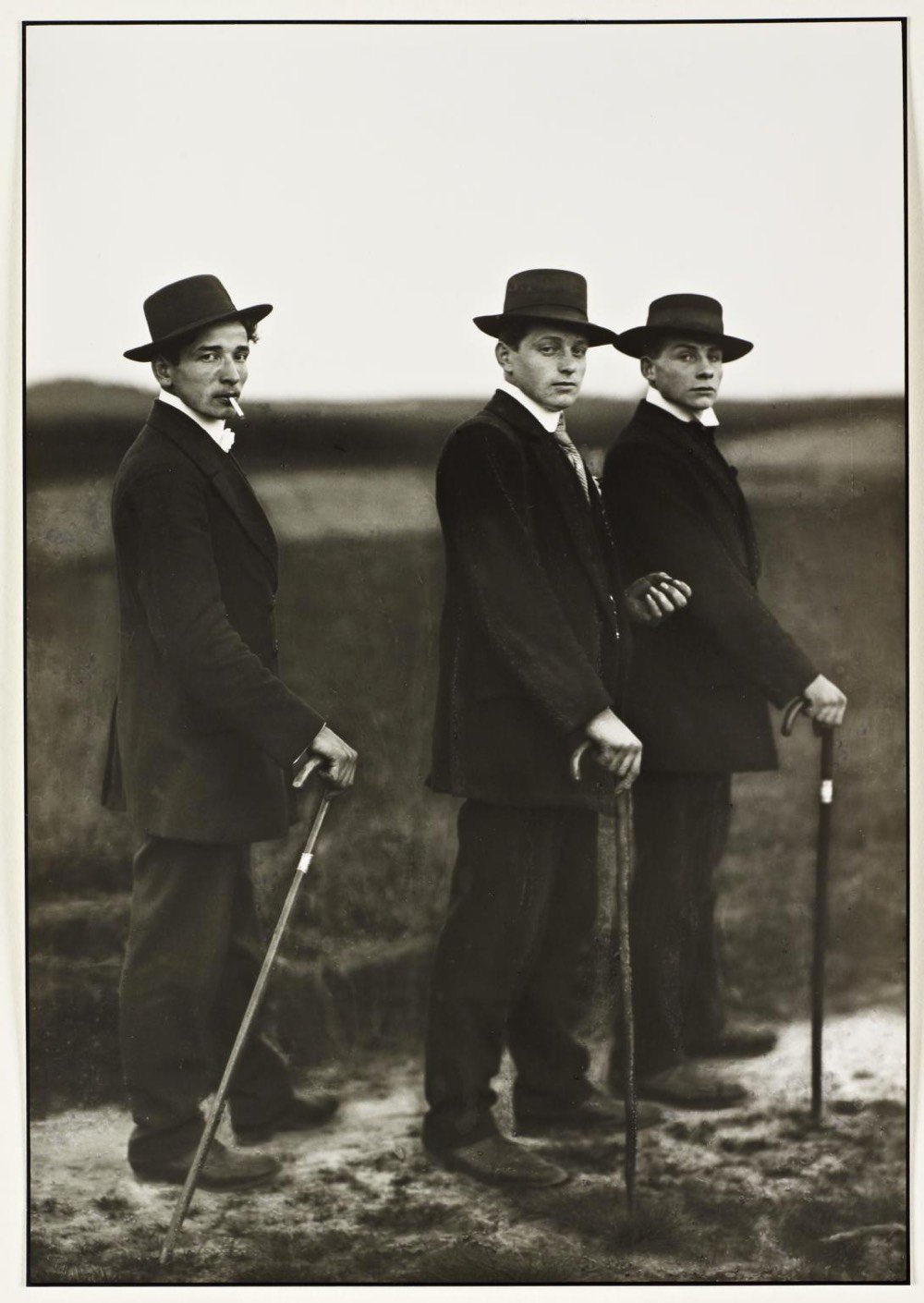
It’s called Young Farmers and it depicts three young men on their way to a dance in rural Germany. But as John Green explains in this video, there is so much more going on with this photo.
From The Tate, which has a print of Young Farmers in its collection:
The Marxist art critic John Berger famously analysed the photograph in his influential essay ‘The Suit and the Photograph’ (1980) writing: ‘The date is 1914. The three young men belong, at the very most, to the second generation who ever wore such suits in the European countryside. Twenty or 30 years earlier, such clothes did not exist at a price which peasants could afford.’ (Berger 1980, p.30.) Berger suggests that these mass market suits, emulating the higher quality attire of the bourgeois urban class, draws attention to, rather than disguises, their ‘social caste’, and not in a particularly flattering sense. In his essay, Berger considers that the three young men are of a social group not beyond the reach of aspirational advertising campaigns and travelling salesmen, and in a state of awkward transition, succumbing to a new ‘cultural hegemony’. The posturing of these three rural ‘lads’, perhaps on their way to a dance, confounds and subverts expectations of the peasant ‘type’, especially in that they smoke cigarettes. Peasants were traditionally depicted smoking a pipe handcrafted from wood, and which like the wooden canes that appear frequently in Sander’s volume of photographs devoted to peasants and farmers, including this one, connoted an organic connection to the native soil as well as a certain time-honoured wisdom. By contrast, the mass-manufactured cigarette was often seen at the time as an urban symbol of social dissolution.
However, Green also cautions that there’s only so much you can infer about people from a photograph (given, for example, that the three men weren’t actually farmers).
This video is from a new-to-me channel called The Art Assignment, which is about art and art history. Subscribed!
Quid Pro Quo: The Three-Act Structure of a Thrilling Scene from The Silence of the Lambs
Jonathan Demme’s The Silence of the Lambs is one of the finest psychological thrillers ever made. In the episode of the always-illuminating Lessons from the Screenplay, the team analyzes a scene from the film with Hannibal Lecter and Clarice Starling that demonstrates how effective scenes follow the same three act structure as entire movies/books/stories do.
The Lessons team also did a podcast episode about the differences between the screenplay for the film and the book that inspired it.
Creatures of Habit
Ron and Diana Watson have been eating dinner at the same restaurant in Wichita 6 nights a week for 15 years. It’s their only meal of the day and they skip the bread because Ron was gaining too much weight from the complimentary dinner rolls.
The ritual is all part of the order Ron Watson likes in his life. A Vietnam veteran, he dines only in restaurants that offer military discounts, and Texas Roadhouse gives vets 10 percent off. He still has some PTSD, he said, and he feels comfortable at table 412, which is a booth at the bar that gives him a good view of the door and everyone coming and going.
The couple also are regular enough customers that they know how to make the most of their money at Texas Roadhouse. Every Sunday through Wednesday, they arrive between 3 and 3:15 p.m. to take advantage of the restaurant’s early bird special, which is available from 3 to 5 p.m. Mondays through Thursdays and offers a full meal for $9.49.
I’m fascinated by people for whom routine is so important. I definitely have those tendencies; I watch favorite shows and movies repeatedly, wear pretty much the same outfit daily, return to familiar vacation destinations, and order the same dishes at the same restaurants again and again. So much of what I do for kottke.org focuses on finding the new — ideas, people, art, discoveries, culture — that it’s comforting to have parts of my life that aren’t relentlessly novel. But I also make ample time for new experiences that bring happiness & fulfillment into my life…and the rest I put on cruise control. (via tmn)
Update: From The Atlantic, The People Who Eat the Same Meal Every Day.
Many of the people I talked with emphasized the stress-reducing benefits of eating the same thing each day. Amanda Respers, a 32-year-old software developer in Newport News, Virginia, once ate a variation on the same home-brought salad (a lettuce, a protein, and a dressing) at work for about a year. She liked the simplicity of the formula, but the streak ended when she and her now-husband, who has more of an appetite for variety, moved in together six years ago. Would she still be eating the salad every day if she hadn’t met him? “Oh heck yeah,” she told me. “It would’ve saved so much time.”
The official trailer for Avengers: Endgame. I am irrationally excited about this movie.
Emma Haruka Iwao used cloud computing to smash the world record for calculating the most digits of pi: about 31.4 trillion decimal places. The old record was about 22.5 trillion.
Pi, the Infinite Doorway to Calculus
Happy Pi Day! In celebration of this gloriously nerdy event, mathematician Steven Strogatz wrote about how pi was humanity’s first glimpse of the power of calculus and an early effort to come to grips with the idea of infinity.
As a ratio, pi has been around since Babylonian times, but it was the Greek geometer Archimedes, some 2,300 years ago, who first showed how to rigorously estimate the value of pi. Among mathematicians of his time, the concept of infinity was taboo; Aristotle had tried to banish it for being too paradoxical and logically treacherous. In Archimedes’s hands, however, infinity became a mathematical workhorse.
He used it to discover the area of a circle, the volume of a sphere and many other properties of curved shapes that had stumped the finest mathematicians before him. In each case, he approximated a curved shape by using a large number of tiny straight lines or flat polygons. The resulting approximations were gemlike, faceted objects that yielded fantastic insights into the original shapes, especially when he imagined using infinitely many, infinitesimally small facets in the process.
Here’s a video that runs through Archimedes’ method for calculating pi:
Strogatz’s piece is an excerpt from his forthcoming book, Infinite Powers: How Calculus Reveals the Secrets of the Universe.
The Most Influential Academic Books in the Last 20 Years
The Chronicle of Higher Education has assembled The New Canon, a list of the most influential books written by academics in the past 20 years or so. The books were chosen by a panel that included sociologist Eric Klinenberg, classics professor Johanna Hanink, and professor of business Sheena Iyengar.
Their picks included Steven Pinker’s The Better Angels of Our Nature: Why Violence Has Declined:
It was a best seller, discussed and praised and criticized by both scholars and public intellectuals. Better Angels defends, at great length, a controversial claim, which is that violence is declining, both in the short run and the long run — and so, in a very important way, the world is getting better. Pinker is far from the first to make this argument, but he presents the most persuasive case. Better Angels also explores, at equally great length, psychological and social theories for why this is so, and illustrates that an evolutionary-psychology approach to the mind can give us considerable insight into how societies change over time.
The New Jim Crow: Mass Incarceration in the Age of Colorblindness by Michelle Alexander:
Michelle Alexander, a legal scholar, activist, and now a columnist for The New York Times, argues that the “war on drugs,” beginning with the Nixon administration and flourishing under Reagan, Bush, and Clinton, shifted antipoverty resources into an infinite war on crime that disproportionately targets black communities and robs the majority of black men in urban areas of their full citizenship. Fusing legal studies and history, Alexander demonstrates how America’s prison-industrial complex is the latest chapter in the nation’s tragic racial history. Her thesis not only touched scholars but also transformed the public’s understanding of structural racism in the American justice system.
Paying for the Party: How College Maintains Inequality by Elizabeth Armstrong & Laura Hamilton is a timely choice given the unfolding college admissions investigation by the FBI:
The book is an ethnographic account of the lives of first-year women college students living on a “party floor” at a selective public university they call Midwest U. Varied in their social-class backgrounds, the students have profoundly different pathways through college. Poor and working-class young women face formidable obstacles to completing their degrees, while the children of upper middle class professionals pursue meaningful majors and vocations. At the same time, the daughters of the wealthiest, socialite families join sororities, and party their way through easy majors, graduation, and, beyond that, socially connected jobs.
If this were a book about no more than individual-level educational inequalities, the story might end there. But this is not that book. Instead, the authors use a cultural and organizational lens to show how the university itself is complicit in shaping students’ academic pursuits, social lives, and job opportunities in socially patterned ways.
Robert Putnam’s Bowling Alone: The Collapse and Revival of American Community:
Americans participate less in group activities that entail coordination and cooperation toward a common purpose. Instead they engage more in activities that take place less regularly, in smaller groups or in isolation. They are less likely to play sports on teams, more likely to watch sports or to exercise at home. The book identifies trends that scholars and journalists continue to analyze and dissect 18 years later, culminating in the recent avalanche of books and essays describing how handheld devices now contribute to the breakdown of community.
Bowling Alone inspired my pal Scott Heiferman to start Meetup.
Bauhaus-Style Logos of Famous Brands

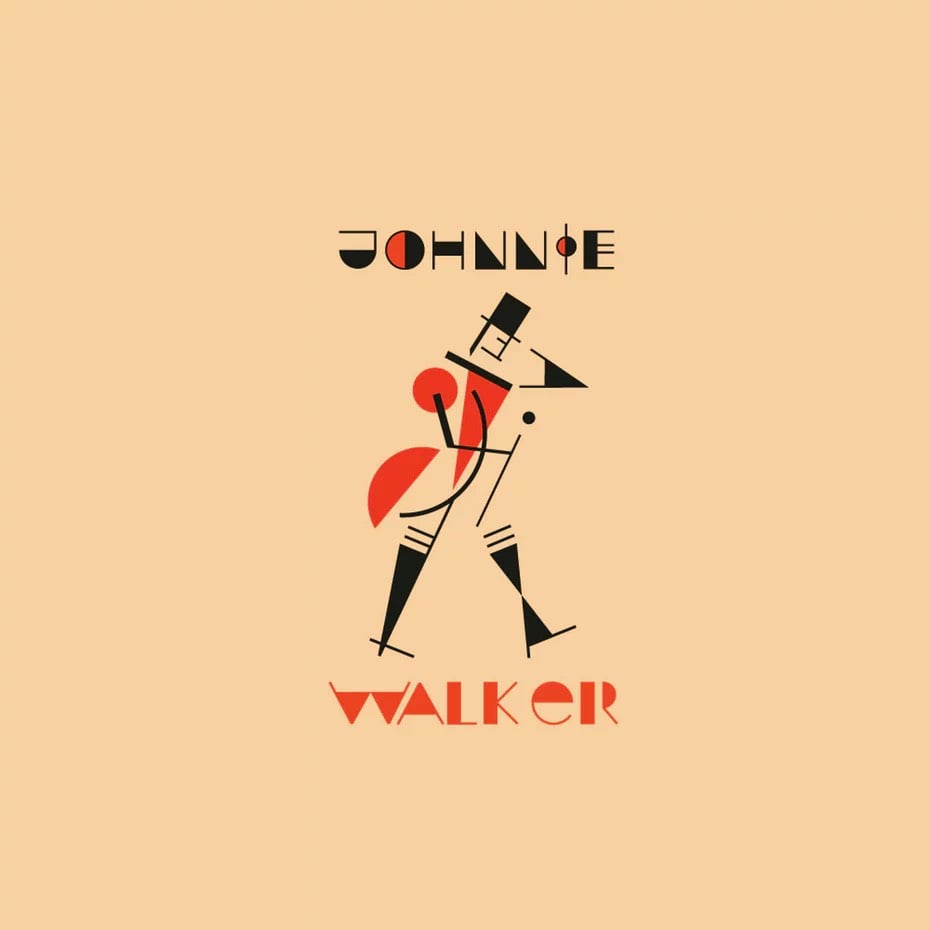

To commemorate the 100-year anniversary of the founding of the Bauhaus design movement, 99designs challenged their community of designers to reimagine the logos of famous brands in a Bauhaus style. (via moss & fog)
A Last Lesson: Buddhist Teacher Thich Nhat Hanh’s Return Home To Vietnam
Thich Nhat Hanh became a Buddhist monk in Vietnam in 1942 and became known over the next few decades as a teacher and peace activist during the Vietnam War, at one point urging Martin Luther King Jr. to publicly denounce the war. For his activism, Nhat Hanh was denied entry back into Vietnam for nearly 40 years.

Now 92 years old, world-renowned as a spiritual leader, and ailing from the aftermath of a stroke he suffered in 2014, Nhat Hanh has returned to his original temple in Vietnam to live out his final days.
The monk’s return to Vietnam to end his life can thus be seen as a message to his disciples. “Thay’s intention is to teach [the idea of] roots and for his students to learn they have roots in Vietnam,” says Thich Chan Phap An, the head of Nhat Hanh’s European Institute of Applied Buddhism. “Spiritually, it’s a very important decision.”
Vox’s Eliza Barclay interviewed Phap Dung, one of Nhat Hanh’s senior disciples, and asked him what his teacher might be trying to say by returning to Vietnam.
He’s definitely coming back to his roots.
He has come back to the place where he grew up as a monk. The message is to remember we don’t come from nowhere. We have roots. We have ancestors. We are part of a lineage or stream.
It’s a beautiful message, to see ourselves as a stream, as a lineage, and it is the deepest teaching in Buddhism: non-self. We are empty of a separate self, and yet at the same time, we are full of our ancestors.
He has emphasized this Vietnamese tradition of ancestral worship as a practice in our community. Worship here means to remember. For him to return to Vietnam is to point out that we are a stream that runs way back to the time of the Buddha in India, beyond even Vietnam and China.
Hiking Interactions
Comedian Miel Bredouw packed every single type of interaction you’re ever going to have with another human being on a hiking trail into a video less than 40 seconds long. As a semi-frequent Vermont hiker (including this recent winter hike), I can vouch for every single one of these. They’re all here: the friendly dog greeting, the sing-song “hello”, the running “excuse me”, and the classic “hey how ya doin?” My go-to is usually the panting “hey”.
Upcoming book of playful and funny charts from @TheRialMichelle: Am I Overthinking This?: Over-Answering Life’s Questions In 101 Charts
Float
Float is a feature-length documentary film directed by Phil Kibbe about “the ultra-competitive sport of elite, stunningly-designed indoor model airplanes”. The main action of the film takes place at the F1D World Championships in Romania, where competitors from all over the world build delicately beautiful rubber-band-powered airplanes and compete to keep them afloat the longest.
After devoting years of time into construction and practice for no material reward, glory becomes their primary incentive. Like any competition, cheating and controversy are an integral part of the sport. FLOAT follows the tumultuous journey of Brett Sanborn and Yuan Kang Lee, two American competitors as they prepare for and compete at the World Championships.
“Designing, building, and flying the planes is truly an experience that requires patience and zen-like focus,” says Ben Saks, producer and subject in the film.
Float began as a Kickstarter project back in 2012…congrats to the team for their patience in getting it finished.
Archaeologists Discover Mayan Chamber Untouched for 1000 Years
While exploring the ground underneath the ancient Mayan city of Chichén Itzá in Mexico, archaeologists found a ritual chamber stuffed with artifacts untouched for more than 1000 years.

De Anda recalls pulling himself on his stomach through the tight tunnels of Balamku for hours before his headlamp illuminated something entirely unexpected: A cascade of offerings left by the ancient residents of Chichén Itzá, so perfectly preserved and untouched that stalagmites had formed around the incense burners, vases, decorated plates, and other objects in the cavern.
“I couldn’t speak, I started to cry. I’ve analyzed human remains in [Chichén Itzá’s] Sacred Cenote, but nothing compares to the sensation I had entering, alone, for the first time in that cave,” says de Anda, who is an investigator with INAH and director of the Great Maya Aquifer Project, which seeks to explore, understand, and protect the aquifer of Mexico’s Yucatan Peninsula.
“You almost feel the presence of the Maya who deposited these things in there,” he adds.
Oddly, the cave was explored by an archaeologist back in 1966, but he ordered the entrance sealed up and the chamber and the objects contained within were forgotten until now.
Pegasus by Jean-Michel Basquiat, “the Most Beautiful Drawing Ever”

The drawing above is Pegasus by Jean-Michel Basquiat. His first art dealer, Annina Nosei, once called it “the most beautiful drawing ever”. I am not going to disagree with her. I’ve only seen Basquiat’s work sporadically, mostly single paintings included in larger exhibitions with Warhols and Harings, but when I saw Pegasus in this short video about the artist’s life & work, it grabbed me, an instant favorite.
The drawing is held in a private collection, but I hope I get to see it in person someday. For more on Basquiat, check out the 2009 documentary Jean-Michel Basquiat: The Radiant Child.
Photos of the Women Clearing One of the Largest Minefields in the World


Photographer Allison Joyce has been in Sri Lanka photographing the women clearing one of the biggest minefields in the world. The mines were left over from the Sri Lankan civil war and the women are employed by NGO HALO Trust.
Landmines were used in vast quantities by both sides at different stages of the fighting in the north. From 2010 to 2012, HALO deminers removed over 30,000 mines a year. By 2014 the total had fallen to 16,000 annually, but those remaining threaten the most economically vulnerable people in the country. Mines present an obstacle to the safe return of internally displaced people (IDPs) and prevent access to paddy fields, fishing jetties and grazing land affecting the lives and livelihoods of thousands of people.
HALO remains the largest international mine action operator in the country. Our 830 staff, including a large proportion of former IDPs, work in the Jaffna, Kilinochchi and Mullaitivu districts. Fifty percent of our deminers are women, many of them war widows with children to support.
In Focus and The Guardian have photo essays about the women and their work.
13 Reasons We Type in Lowercase. Fun fact: the first year or two of @kottke posts were entirely in lowercase (for intimacy/casualness reasons).
Learned about swerve skiing this weekend. It involves wearing track pants, doing unconventional tricks, and a ton of athleticism.
How to Play Pac-Man
The highest score a player can get in Pac-Man is 3,333,360. In a fascinating recent article on the game, Cat DeSpira doesn’t tell us how to play the digital game on the screen but instead shows how people interact with the physical artifact of the cabinet while playing Pac-Man. Specifically, she notes that the particular pattern of wear on the sides of Pac-Man machines arises from the nature of the game.
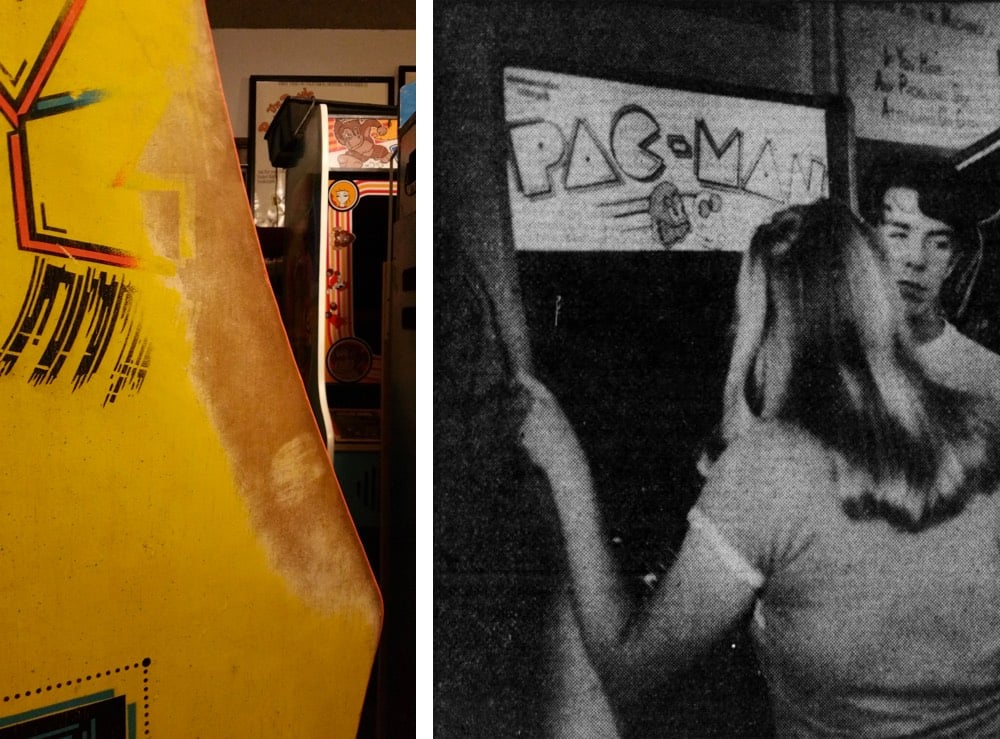
Pac-Man is more of a driving game than a maze game. As you’re playing, you’re jamming that joystick left and right, up and down, movements that shifts your right shoulder forward and back, rocking your body side to side. When the going gets tough, and the ghosts start closing in, all of this rocking motion compels you to lean into the game and, whether you realize you’re doing it or not, you’re going to grab onto the game. You actually need to get a grip…on something. You’re either going to lean hard against your left palm as it rests on the control panel which isn’t comfortable for very long or, like most people, you’re going to grab the side of the game and hold on tight. You have to or you’ll lose your balance. You can’t take the sharp corners smoothly and quickly without doing this, ether. You need the extra stabilization to move Pac-Man around the corners accurately.
Many owners have “restored” the worn sides of their games so they look like new, but DeSpira argues that covers up a vital aspect of gaming history:
Pac-Man’s worn left-side is part of the game’s provenance. It’s unique only to Pac-Man games, including Ms. Pac-Man. It’s evidence left by “Pac-Mania” and also evidence of how the game was really played. It’s a time signature left by a generation of the first gamers. It’s history that should be preserved intact. It tells a story that we’ll never see written again.
Why anyone would want to destroy something that reflects a cultural phenomenon in gaming boggles my mind. It’s confusing even more to me that people can’t see it, can’t see the worn side of the game and know exactly what put it there and find it beautiful — hands. Thousands of human hands. Millions, even. Hands of many colors, many sizes; white collar hands, blue collar hands, no-collar hands. Hands that put a quarter in a machine that was attacked by the press as being “addicting” and “unhealthy”. Ordinances were passed that helped kill the video craze off early because of Pac-man, because a generation of newly risen gamers couldn’t keep their hands off it and, in a free country, shouldn’t have been expected to anyway. That scar was put there by an act of defiance.
(thx, s. ben)
The Unintended Benefits Of Vaccines. As demonstrated by a recent study, they often protect against illnesses and diseases other than their target disease.
The Robots Are Coming for Our Jobs (Thank God)
At SXSW, Congresswoman Alexandria Ocasio-Cortez was asked by an audience member about the economic challenge of a significant percentage of our labor force being replaced by automation. She responded, in part, by suggesting we decouple the idea of employment with being able to remain alive:
We should not be haunted by the specter of being automated out of work. We should not feel nervous about the toll booth collector not having to collect tolls anymore. We should be excited by that. But the reason we’re not excited by it is because we live in a society where if you don’t have a job, you are left to die. And that is, at its core, our problem.
Then she went on to say:
We should be excited about automation, because what it could potentially mean is more time educating ourselves, more time creating art, more time investing in and investigating the sciences, more time focused on invention, more time going to space, more time enjoying the world that we live in. Because not all creativity needs to be bonded by wage.
Her full answer, including a bit about “automated inequality”, is worth worth watching in full, starting at ~55:15:
In a 1970 article in New York magazine, the architect and futurist Buckminster Fuller wrote about the collision of technology and “this nonsense of earning a living”:
We must do away with the absolutely specious notion that everybody has to earn a living. It is a fact today that one in ten thousand of us can make a technological breakthrough capable of supporting all the rest. The youth of today are absolutely right in recognizing this nonsense of earning a living. We keep inventing jobs because of this false idea that everybody has to be employed at some kind of drudgery because, according to Malthusian-Darwinian theory, he must justify his right to exist. So we have inspectors of inspectors and people making instruments for inspectors to inspect inspectors. The true business of people should be to go back to school and think about whatever it was they were thinking about before somebody came along and told them they had to earn a living.
(thx to @claytoncubitt for the AOC-Fuller connection)
Hilarious video about all of the sequels to Tetris, including Hatris and a game called Faces… Tris III (not making this up).
A Day in the Life at a Bell Labs Datacenter in the Late 60s
Larry Luckham was a manager at a Bell Labs data center in Oakland in the late 60s and early 70s. One day, he captured daily life at the company with his camera.
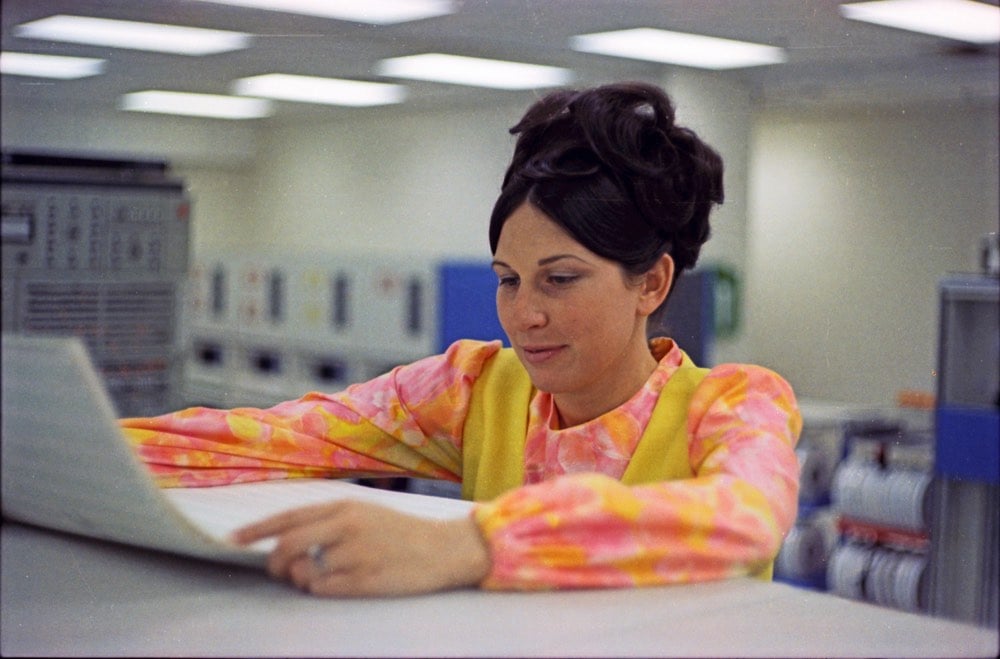
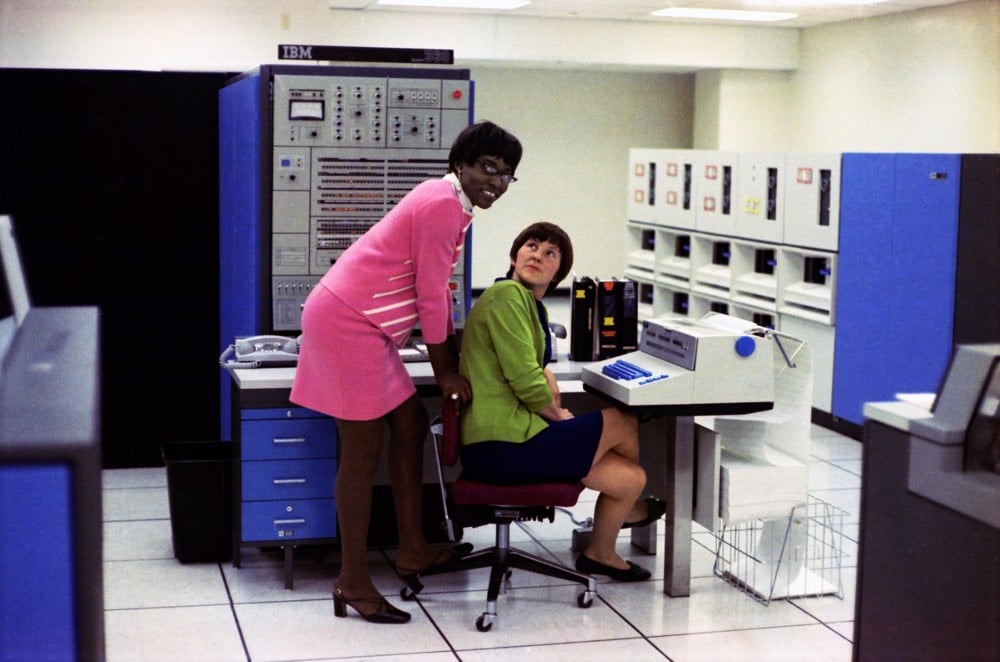

Note how many of his coworkers were women, including women of color. From The Secret History of Women in Coding:
A good programmer was concise and elegant and never wasted a word. They were poets of bits. “It was like working logic puzzles — big, complicated logic puzzles,” Wilkes says. “I still have a very picky, precise mind, to a fault. I notice pictures that are crooked on the wall.”
What sort of person possesses that kind of mentality? Back then, it was assumed to be women. They had already played a foundational role in the prehistory of computing: During World War II, women operated some of the first computational machines used for code-breaking at Bletchley Park in Britain. In the United States, by 1960, according to government statistics, more than one in four programmers were women. At M.I.T.’s Lincoln Labs in the 1960s, where Wilkes worked, she recalls that most of those the government categorized as “career programmers” were female. It wasn’t high-status work — yet.
This portmanteau generator is a pun-lover’s paradise. Lexiconoisseurs will be able to gramurder folks with cleverbs & wittyoms.
Tiny Private Mind-Motions
Prompted by a line from a poem by Tracy K. Smith, Sam Anderson writes about the thoughts that come unbidden to our minds during the course of our day.
Every morning, when I screw the lid onto my steaming thermos of coffee, I think to myself, automatically, the phrase “heat capture.” I have no idea why. I’ve never used that phrase in any other context in my life. And yet I couldn’t stop it if I tried. After years of this, I finally mentioned it to my wife, who revealed a similar habit: Every night, when she shuts the bedroom blinds, she thinks to herself the ridiculous words, “Sleep Chamber: Complete.” She said she kind of hates it because it makes her feel as if she’s living in an episode of “Star Trek,” but she has no choice.
Anderson calls these involuntary thoughts “tiny, private mind-motions”. I have a bunch of these — saying “hey” to the tiny pareidolia faces hidden in my bathroom’s wood paneling, recasting the word “debris” as “derbis” — but the one I’ve been noticing the most lately is nearly every time I run across a two-syllable word or phrase, my brain responds with the Batman jingle.
Na na na na na na na na na na na na snack bags!
Na na na na na na na na na na na na passport!
Na na na na na na na na na na na na Meek Mill!
Na na na na na na na na na na na na sport mode!
Na na na na na na na na na na na na Kottke!
(via na na na na na na na na na na na na craig mod)
My Favorite Secret Social Network

If, for some reason, you join Peach, and you find my handle there, and you add me as a friend — maybe we’re IRL friends, or friends from other social network, or we used to work together, or you know me from here or someplace else — don’t be surprised if I don’t reciprocate your friendship right away.
Being Peach friends is a very special thing, and it doesn’t map neatly onto other kinds of friendship, digital or otherwise. The only way to know if someone is a good Peach friend is if they’ve been a good friend on Peach, which above all means one is supportive, discreet, and chill. The only other way to know if someone is a good Peach friend is if they’re not one of the people you go to Peach to talk about with your discreet, supportive, supremely chill Peach friends.
Confused? Yeah, it’s confusing to me too. The best effort at sorting it out in public so far is by Navneet Alang, who in “Notes on Peach” writes about why a small handful of us love this buggy, unreliable, deeply unpopular social network so much:
Most of all, there is no central feed. Instead, you have to click on each friend’s individual profile, which, first, limits the number of people you want to have on it, and second, makes things weirdly intimate, confessional, like you’re really writing to yourself and other people just happen to read. Of the odd mix that makes up my friend list of about fifteen—a couple of IRL friends, a few pals from Twitter, and a few complete strangers in another country—most use it as a sort of ongoing diary for the things you can’t say elsewhere, a release valve from the glare of Twitter. It is the sort of app where you talk about having a headache, the fact that you’re horny, a memory you have of your father that still fucks you up, and of course, pictures of your dog, mostly to a cobbled-together group of people you’ve never even met who, for some unknown reason, have all agreed not to judge.
I am the sort of person who has posted the following tweets in public, under my government name:
Writing is like sex because there are so many different ways to do it for the wrong reasons and with the wrong people
— Tim Carmody (@tcarmody) August 26, 2017
Writing is like sex in that people say I’m really good at it, but eventually they all decide I’m not worth the trouble
— Tim Carmody (@tcarmody) August 26, 2017
I’m posting them here again because frankly, I don’t think they got enough attention the first time. That’s who I am and what I’m about.
I blush to think at my Peach posts ever being made public. Or even private in a different context.
That’s what Peach is for. It is a place to be real with people who’ve chosen to be real with you. It’s friendly, it’s therapeutic, it’s cathartic. It’s necessary. When it’s not around, those of us who use it go a little bit mad.
We’ve come to lean on confessing out loud. And there are no priests left who can be trusted any more. The only thing we can trust is benign neglect.
Is that the next phase of the web? The web that hardly works, where no one’s paying attention because no one really cares? (Except your friends, including strangers, who somehow care so much?)1
As Bill Callahan wrote, “Everyone’s got their own thing that they yell into a well.”
Remaking the Servant Economy

Alexis Madrigal looks at the vast body of “Uber-for-X” sharing economy companies and sees something that’s historically new, but very familiar:
The haves and the have-nots might be given new names: the demanding and the on-demand. These apps concretize the wild differences that the global economy currently assigns to the value of different kinds of labor. Some people’s time and effort are worth hundreds of times less than other people’s. The widening gap between the new American aristocracy and everyone else is what drives both the supply and demand of Uber-for-X companies.
The inequalities of capitalist economies are not exactly news. As my colleague Esther Bloom pointed out, “For centuries, a woman’s social status was clear-cut: either she had a maid or she was one.” Domestic servants—to walk the dog, do the laundry, clean the house, get groceries—were a fixture of life in America well into the 20th century. In the short-lived narrowing of economic fortunes wrapped around the Second World War that created what Americans think of as “the middle class,” servants became far less common, even as dual-income families became more the norm and the hours Americans worked lengthened.
What the combined efforts of the Uber-for-X companies created is a new form of servant, one distributed through complex markets to thousands of different people. It was Uber, after all, that launched with the idea of becoming “everyone’s private driver,” a chauffeur for all.
An unkind summary, then, of the past half decade of the consumer internet: Venture capitalists have subsidized the creation of platforms for low-paying work that deliver on-demand servant services to rich people, while subjecting all parties to increased surveillance.
What else is there to say?
The 50th edition of Noticing, the @kottke newsletter, just went out. Hot Shit Science, Ancient Wisdom, Pop Stars In New Contexts, and a little meta self-reflection to close things out; this newsletter has it all
Stacey Abrams, Star Trek Superfan

Georgia politician, almost-Governor, and Democratic superstar Stacey Abrams has a secret to her success: she loves Star Trek. In particular, she loves my favorite Trek series, Star Trek: The Next Generation.
In explaining her approach to politics as a black Democratic woman in a state controlled by white Republican men, she devotes several pages to a pivotal scene from “Peak Performance,” an episode from “Star Trek: The Next Generation.”
In the episode, Data, the preternaturally pale android with a greenish cast to his skin, is playing Strategema, a game that appears to be some incredibly complicated form of 3-D holographic chess, against a humanoid grandmaster named Kolrami. Data cannot defeat Kolrami, he discovers, but he can outlast him, drive him into a rage and force him to quit the game, which is itself a kind of victory.
Ms. Abrams writes that this has helped her focus her own thinking. “Data reframed his objective — not to win outright but to stay alive, passing up opportunities for immediate victory in favor of a strategy of survival,” she says in the book. “My lesson is simpler: change the rules of engagement.”

This sparked some predictably joyous reactions among Star Trek fans:
Stacey Abrams is a STAR TREK FAN?! Please insert that viral “Unfollow me now, this is the only thing I’m going to talk about all day” gif…
— Ebony Elizabeth (@Ebonyteach) March 7, 2019
(And she loves Queen Nichelle? And this article came out just in time for #TrekThursday, with more DSC tonight?)
@EbWatchesTrek
And the following thoughtful thread from Manu Saadia (@trekonomics) on the history of progressive politics, as modeled in the Star Trek universe:
First off, that piece by historian @robgreeneII should convince @staceyabrams to take a second L ok at Deep Space 9.https://t.co/nlcpDm0svC
— manu saadia (@trekonomics) March 8, 2019
Next, that long and detailed piece of Trek fandom. A special piece for me, as we had drinks with @mollitudo at the Convention in Vegas while she was reporting it. The Utopia is the fandom. https://t.co/FodCf34kXU
— manu saadia (@trekonomics) March 8, 2019
A look at 10 episodes:https://t.co/bmmWGzdbs2
— manu saadia (@trekonomics) March 8, 2019
I am always embarrassed to mention myself, especially in such great company, but here we are. https://t.co/g1gbNqr1Yi
— manu saadia (@trekonomics) March 8, 2019
Politics is also about gender roles.https://t.co/HxEs3AoZjS
— manu saadia (@trekonomics) March 8, 2019
And guess what, MLK was a fan - and convinced Nichelle Nichols to stay on that silly space show after the first season.https://t.co/hhPFJEBWUr
— manu saadia (@trekonomics) March 8, 2019
The sexual politics of Trek became more and intriguing as the show matured. Jadzia Dax, DS9’s science officer and “old man” (eh!), was particularly adventurous - (and deftly incarnated by) @4TerryFarrell https://t.co/ZwQrHnL3r3
— manu saadia (@trekonomics) March 8, 2019
Star Trek is a powerful source for political imagination. It is the Utopia of our times.
— manu saadia (@trekonomics) March 8, 2019
Star Trek is a thought experiment on how humans would behave under terminally improved conditions. This is why it matters. There’s very little sci-fi that takes on that big question.
— manu saadia (@trekonomics) March 8, 2019
Live long and prosper! And no, it doesn’t mean “make money!” pic.twitter.com/U4NTO1vd4z
— manu saadia (@trekonomics) March 8, 2019
It actually is possible to overthink this. All of this about politics and the imagination and utopian possibilities is true. But at the same time, ultimately, it’s just a really cool show. It’s one we grew up with. And as politicians get younger, it’s one we’ve always had with us, framing our background on entertainment, war, morality, politics, economics — everything.
The world the original Star Trek entered was one where space was only beginning to open, as a direct consequence of the nuclear and geopolitical crisis than enveloping the planet. Now, we have all new geopolitical crises to deal with. Star Trek offers a surprisingly resilient fictional framework for understanding most if not all of them. That’s a powerful tool. It’s foolish to pass it up.
Oh, and Ms. Abrams — keep bustin’ ‘em up.
“Music: A Subversive History”, a forthcoming book by music historian and critic @tedgioia. “Histories of music overwhelmingly suppress stories of the outsiders and rebels who created musical revolutions…”
100-Year-Old Holocaust Survivor Helen Fagin on How Books Save Lives
Starting when she was 21, Helen Fagin was imprisoned by the Nazis in the Radomsko and Warsaw ghettos in Poland. Her parents were sent to Treblinka and murdered there, but Fagin and her sister eventually managed to escape and, after a long journey around Europe, made it to the United States. Fagin has offered lengthy testimony about her experience of the Holocaust (for the USC Shoah Foundation and US Holocaust Memorial Museum), but in this short video, she reads a letter she wrote about how reading and stories gave a spark of hope to those under the Nazi boot in Warsaw.
Could you imagine a world without access to reading, to learning, to books?
At twenty-one, I was forced into Poland’s WWII ghetto, where being caught reading anything forbidden by the Nazis meant, at best, hard labor; at worst, death.
There, I conducted a clandestine school offering Jewish children a chance at the essential education denied them by their captors. But I soon came to feel that teaching these sensitive young souls Latin and mathematics was cheating them of something far more essential — what they needed wasn’t dry information but hope, the kind that comes from being transported into a dream-world of possibility.
One day, as if guessing my thoughts, one girl beseeched me: “Could you please tell us a book, please?”
I had spent the previous night reading Gone with the Wind — one of a few smuggled books circulated among trustworthy people via an underground channel, on their word of honor to read only at night, in secret. No one was allowed to keep a book longer than one night — that way, if reported, the book would have already changed hands by the time the searchers came.
The full text of the letter is here and is also collected in the book The Velocity of Being. (via open culture)
The Partisan States of America
The Atlantic recently teamed up with polling and analytics company PredictWise to build a county-by-county map of political open-mindedness in America.

In general, the most politically intolerant Americans, according to the analysis, tend to be whiter, more highly educated, older, more urban, and more partisan themselves. This finding aligns in some ways with previous research by the University of Pennsylvania professor Diana Mutz, who has found that white, highly educated people are relatively isolated from political diversity. They don’t routinely talk with people who disagree with them; this isolation makes it easier for them to caricature their ideological opponents. (In fact, people who went to graduate school have the least amount of political disagreement in their lives, as Mutz describes in her book Hearing the Other Side.) By contrast, many nonwhite Americans routinely encounter political disagreement. They have more diverse social networks, politically speaking, and therefore tend to have more complicated views of the other side, whatever side that may be.
We see this dynamic in the heat map. In some parts of the country, including swaths of North Carolina and upstate New York, people still seem to give their fellow Americans the benefit of the doubt, even when they disagree. In other places, including much of Massachusetts and Florida, people appear to have far less tolerance for political difference. They may be quicker to assume the worst about their political counterparts, on average.
If you click through to the article, the interactive map will let you see how prejudiced your county is. There are also maps for Republican on Democratic prejudice and Democratic on Republican prejudice.
This map is a little bit bonkers…I can’t wrap my head around some of the results. Why are Florida and South Carolina so polarized while the states surrounding them are not? And look at New York…aside from NYC, there’s relatively little polarization right up against a very polarized New England and Pennsylvania. Utah sticks out among western states but you can probably chalk that up to Mormonism. Is this a methodology problem or is it due to something fundamentally different about the states and/or their governments?
Thousands of New Millionaires Are About to Eat San Francisco Alive. “Uber, Lyft, Airbnb and Pinterest plan to go public. California’s newly minted rich will be hungry for parties, houses, boats, bikes…”
Fred Rogers Was Attracted to Both Men and Women
Like many people my age, Mister Rogers had a large influence on me in terms of how to act as a man. As Maxwell King wrote in The Good Neighbor: The Life and Work of Fred Rogers, he was not perceived at the time to be traditionally masculine:
Rogers himself was often labeled “a sissy,” or gay, in a derogatory sense. But as his longtime associate Eliot Daley put it: “Fred is one of the strongest people I have ever met in my life. So if they are saying he’s gay because… that’s a surrogate for saying he’s weak, that’s not right, because he’s incredibly strong.” He adds: “He wasn’t a very masculine person, he wasn’t a very feminine person; he was androgynous.”
In a 1975 interview for the New York Times, Rogers noted drolly: “I’m not John Wayne, so consequently, for some people I’m not the model for the man in the house.”
When I was little, Mister Rogers was the man of the house. My dad worked a lot and I sometimes only saw him for a few hours on weekends. Instead, my male role models were Captain Kangaroo, the men of Sesame Street (Mr. Hooper, Bob, Gordon, and Luis), and, most of all, Fred Rogers.
Now, some in the LGBTQ+ community are finding Fred Rogers to be a posthumous bisexual role model. Directly after the passage above, King continues:
In conversation with one of his friends, the openly gay Dr. William Hirsch, Fred Rogers himself concluded that if sexuality was measured on a scale of one to ten: “Well, you know, I must be right smack in the middle. Because I have found women attractive, and I have found men attractive.”
As Out’s Mikelle Street notes, it’s tough to tell what Rogers meant by that in terms of his sexuality. We do know he was married to his wife Joanne for more than 50 years until his death in 2003. Rogers also advised François Clemmons, who played Officer Clemmons and came out as gay during his time on the program (though not on air), to not go to gay bars while working on the show and encouraged him to marry a woman.
Clemmons did but then divorced his wife to live as an openly gay man, piercing his ear as a sign of his sexuality. He was not allowed to wear earrings while filming though — for years Clemmons masked his own sexuality, under the advice of Rogers, in an effort to be successful.
Could it be that the actor was less forthcoming about his sexuality because he understood what Hollywood then required for success?
If Street is right, perhaps Rogers didn’t come out publicly about his sexuality for the same reason he advised Clemmons to mask being gay and the same reason millions of other people didn’t in the 70s and 80s: fear of social stigma. As King repeatedly writes in the book, Rogers always put the needs of the small children who watched his program above all other concerns. Perhaps he felt that a potential scandal about his sexuality, even a small one, was not worth jeopardizing his relationship with his television neighbors.
For Clemmons though, there was little doubt that Rogers accepted him for who he was:
He says he’ll never forget the day Rogers wrapped up the program, as he always did, by hanging up his sweater and saying, “You make every day a special day just by being you, and I like you just the way you are.” This time in particular, Rogers had been looking right at Clemmons, and after they wrapped, he walked over.
Clemmons asked him, “Fred, were you talking to me?”
“Yes, I have been talking to you for years,” Rogers said, as Clemmons recalls. “But you heard me today.”
“It was like telling me I’m OK as a human being,” Clemmons says. “That was one of the most meaningful experiences I’d ever had.”
Update: Clemmons spoke at length in this Vanity Fair interview about his relationship with Rogers, his sexuality, and appearing on the show. One excerpt:
And [during the show], I could not handle people having an open discussion about the fact that François Clemmons is living with his lover. I did feel like I was risking [something], because people knew who I was. I had a full conversation with Fred about what it could possibly do to the program and to my role on the program, and I didn’t feel I wanted to risk it. You know, the articles that have talked about me, I don’t think they’ve taken into full account that societal norms were vastly different than what they are right now.
The White Horse Tavern has been sold to a “notorious landlord”. This doesn’t sound like a promising new chapter for a storied NYC institution.
Van Gogh’s The Night Café Was Among His “Ugliest Pictures”
In a letter to his brother Theo, Vincent van Gogh called his 1888 oil painting The Night Café “one of the ugliest pictures I have done”.
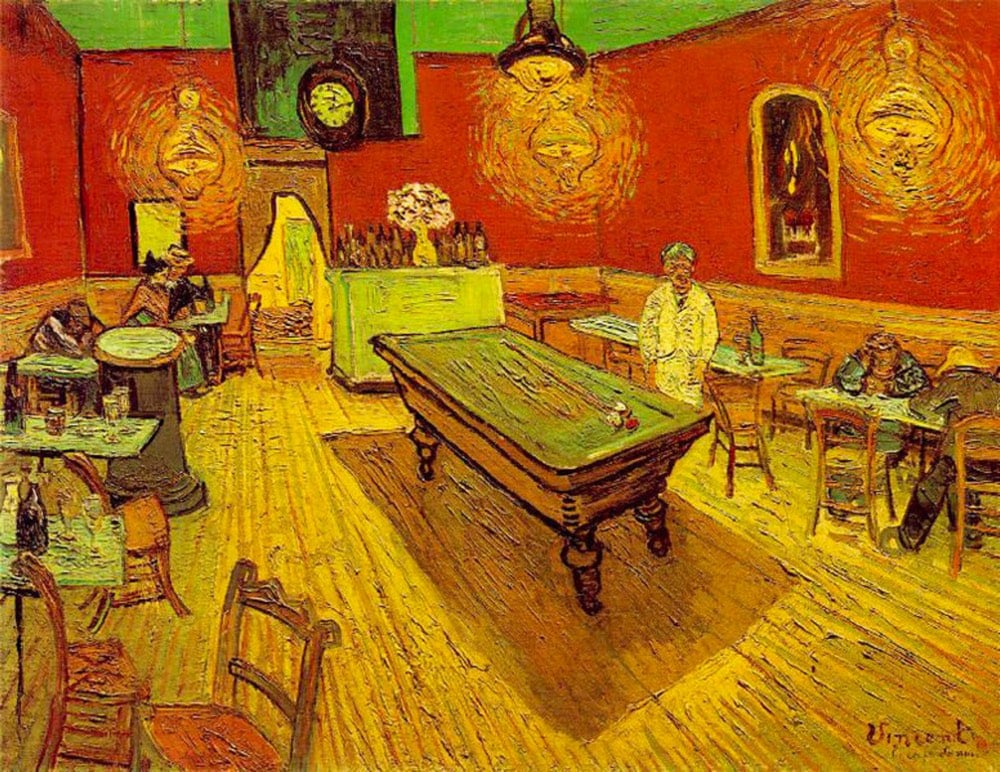
In this video, Evan Puschak looks at what van Gogh meant by that and how he used discordant colors together to suggest a mood.
van Gogh wrote of his intentions for the painting to his brother:
I have tried to express the terrible passions of humanity by means of red and green. The room is blood red and dark yellow with a green billiard table in the middle; there are four lemon-yellow lamps with a glow of orange and green. Everywhere there is a clash and contrast of the most alien reds and greens, in the figures of little sleeping hooligans, in the empty dreary room, in violet and blue. The blood-red and the yellow-green of the billiard table, for instance, contrast with the soft tender Louis XV green of the counter, on which there is a rose nosegay. The white clothes of the landlord, watchful in a corner of that furnace, turn lemon-yellow, or pale luminous green.
Let’s Talk About Hagfish and Their Wondrously Soft Slime
Hagfish are an eel-like sea creatures with the ability to excrete a teaspoon of slime that almost instantly expands to 10,000 times the volume. The slime, a combination of mucous and protein threads, is magical, too! Surprise, it’s not sticky, and it’s actually incredibly soft. Think about the softest thing you can think of. WRONG, this is softer. Hagfish slime is so soft, scientists had to create new ways to measure it when traditional instruments couldn’t hack it.
The proteins threads that give the slime cohesion are incredible in their own right. Each is one-100th the width of a human hair, but can stretch for four to six inches. And within the slime glands, each thread is coiled like a ball of yarn within its own tiny cell — a feat akin to stuffing a kilometer of Christmas lights into a shoebox without a single knot or tangle. No one knows how the hagfish achieves this miracle of packaging, but Fudge just got a grant to test one idea. He thinks that the thread cells use their nuclei — the DNA-containing structures at their core — like a spindle, turning them to wind the growing protein threads into a single continuous loop.
But that’s not all! Hagfish don’t have a jawbone, they’ve got kind of a sandpaper on their face, which is not the scientific way to describe it at all. They eat by burrowing into carcasses and rub their face around to get their fill. The skin of a hagfish is more efficient at processing nutrients than their intestines, so needless to say the burrowing really works for them. While hagfish use their slime to defend against attacks — the excreted slime clogs the gills of attackers — they also use their ridiculously squishy bodies as a defense. If a shark bites them, the important bits squish out of the way like one of those water wiggly toys. (Do you know how hard it is is to google the name of a toy you’ve played with your entire life without ever having known the name of? “Squishy squiggly water snake” is what worked for me.) Lastly, hagfish tie themselves in knots to rid themselves of slime AND to help them eat when they’re inside the dead bodies of recently passed sea friends. Now you know.
As a hagfish cleanser, sea otters hold hands while they’re sleeping so they don’t drift apart.
(Allow me an aside. The last time I wrote about the wacky world of sea creatures on Kottke.org, it was a post about the first known case of the sperm of cooked squid implanting in someone’s mouth. (At the time, of course, everyone knew the sperm of raw squid could implant, but this first case of cooked squid doing the same was big news).)
Clouds in Unexpected Places


Dutch artist Berndnaut Smilde creates ephemeral water vapor sculptures (you know, clouds!) in places you normally wouldn’t find them, like inside churches & museums. He shared some of his process with National Geographic:
The ingredients for Smilde’s clouds: just smoke and water vapor. He requires a cold and damp space with no air circulation, lest the clouds never form or fall straight to the ground. He mists an area with a spray bottle to put water vapor into the air. Then he turns on fog machines that spout tiny particles, and the vapor condenses around them.
Smilde runs around the forming cloud, coaxing it into a shape about 10 feet across and six feet tall. Then he steps back long enough for a photographer to snap several images. Once the air clears, he’ll start over, repeating the process dozens of times until he’s happy with the results. Later, he’ll retouch the photos to remove his tools.
(via moss & fog)
A concept cafe in Japan was staffed by people with disabilities who remotely controlled robotic servers. The goal was to “enable physical work and social participation” by those who may otherwise find those activities impossible.
Why Generalists Triumph in a Specialized World
As a hardcore generalist, David Epstein’s forthcoming book is intriguing to me: Range: Why Generalists Triumph in a Specialized World.
David Epstein, author of the New York Times bestseller The Sports Gene, studied the world’s most successful athletes, artists, musicians, inventors, forecasters and scientists. He discovered that in most fields — especially those that are complex and unpredictable — generalists, not specialists, are primed to excel. Generalists often find their path late, and they juggle many interests rather than focusing on one. They’re also more creative, more agile, and able to make connections their more specialized peers can’t spy from deep in their hyperfocused trenches. As experts silo themselves further while computers master more of the skills once reserved for highly focused humans, people who think broadly and embrace diverse experiences and perspectives will increasingly thrive.
They will also somehow not be that much better at trivia and will be unable to talk authoritatively about a single topic with a genuine enthusiast or expert for more than 2-3 minutes before starting in on the “I don’t knows”. Wait, just me?
Richard MacManus, an OG blogger himself, interviewed me for @readcreators about why I’m sticking with an unfashionable media format. I enjoyed working in a reference to Marshawn Lynch explaining Beast Mode.
A Light Installation in a Scottish Coastal Town Vividly Shows Future Sea Level Rise


Lines (57° 59´N, 7° 16´W) is a light installation in Lochmaddy, Scotland that visualizes how much the sea level will rise if our climate keeps changing at its current pace. Co-collaborators Timo Aho and Pekka Niittyvirta installed sensors to detect high tide, which then illuminates lights showing what the high tide will look like in the future.
The installation explores the catastrophic impact of our relationship with nature and its long-term effects. The work provokes a dialogue on how the rising sea levels will affect coastal areas, its inhabitants and land usage in the future.
This is specifically relevant in the low lying island archipelago of Uist in the Outer Hebrides off the west coast of Scotland, and in particular to Taigh Chearsabhagh Museum & Arts Centre in Lochmaddy where the installation is situated. The Centre cannot develop on its existing site due to predicted storm surge sea levels.
(via colossal)
Pocket, an ace short film about the digital life of a teen. “If something happens but you didn’t capture it on your phone, did it even happen?”
Regarding the Thoughtful Cultivation of the Archived Internet
Kurzgesagt is one of my favorite YouTube channels. Their videos are entertaining & thoroughly researched, and the subject matter is right in the kottke.org wheelhouse. (This one on the physical limitations of humanity when it comes to space exploration is a particular recent favorite.)
So I appreciated their latest video called Can You Trust Kurzgesagt Videos?
In it, they detail the process of making their videos, which has gotten more extensive as the channel matures. The second half is about a pair of videos that didn’t meet their current standard: one about addiction (which I posted about here) and another about the European migrant crisis of 2015. The addiction video represented only one side of a controversial issue within the scientific community while the migrant video was hastily produced and poorly researched. As a result, they deleted both videos, even though they were among the channel’s most popular and plan to publish a future video about addiction that will look more broadly at its causes.
With 20+ years of kottke.org archives, I’ve been thinking about this issue as well. There are many posts in the archive that I am not proud of. I’ve changed my mind in some cases and no longer hold the views attributed to me in my own words. I was too frequently a young and impatient asshole, full of himself and knowing it all. I was unaware of my privilege and too frequently assumed things of other people and groups that were incorrect and insensitive. I’ve amplified people and ideas in the past that I wouldn’t today.
My process today is more rigorous (but not as rigorous as Kurzgesagt b/c we have different aims) and I’ve gained some wisdom (I hope!) about when vigor or sensitivity are called for. I still place a lot of responsibility on the shoulders of the reader — you are a smart bunch and I expect you to read and view everything here with a critical eye — but I am also more aware of my (small but not insignificant) responsibility as an informational gatekeeper.
But so anyway, I don’t know what to do about those old problematic posts. Tim Berners-Lee’s idea that cool URIs don’t change is almost part of my DNA at this point, so deleting them seems wrong. Approximately no one ever reads any post on this site that’s more than a few years old, but is that an argument for or against deleting them? (If a tree falls in the woods, etc…) Should I delete but leave a note they were deleted? Should I leave the original posts but append updates citing my current displeasure? Or like Mister Rogers used to do, should I rewrite the posts to bring them more into line with my current thinking? Is the kottke.org archive trapped in amber, a record of what I’ve written when I wrote it, or is it a living, breathing thing that thrives on activity? Is it more like a book or a performance? In my mind it’s both, which is why the site is compelling (IMO) but also makes this issue so thorny for me. The web is weird that way…but how do I embrace the weirdness re: this issue?
An animated map of population density in the US (1790-2010). Note: this excludes indigenous populations.
The Case of the 500-Mile Email
I’ve shared this here before, but one of my favorite Old Weird Internet stories is Trey Harris’ The case of the 500-mile email. If you’ve ever worked in tech support or system administration (or have been on the receiving end of stories by people doing that work), a common trope features someone (usually a boss of some sort) thinking they’ve stumbled across a bug when in fact it’s user error. That’s not where this story goes…
I was working in a job running the campus email system some years ago when I got a call from the chairman of the statistics department.
“We’re having a problem sending email out of the department.”
“What’s the problem?” I asked.
“We can’t send mail more than 500 miles,” the chairman explained.
I choked on my latte. “Come again?”
“We can’t send mail farther than 500 miles from here,” he repeated. “A little bit more, actually. Call it 520 miles. But no farther.”
“Um… Email really doesn’t work that way, generally,” I said, trying to keep panic out of my voice. One doesn’t display panic when speaking to a department chairman, even of a relatively impoverished department like statistics. “What makes you think you can’t send mail more than 500 miles?”
“It’s not what I *think*,” the chairman replied testily. “You see, when we first noticed this happening, a few days ago—”
“You waited a few DAYS?” I interrupted, a tremor tinging my voice. “And you couldn’t send email this whole time?”
“We could send email. Just not more than—”
“—500 miles, yes,” I finished for him, “I got that. But why didn’t you call earlier?”
Read the whole thing if you’ve never had the pleasure.
Crack Pie, Girly Drinks, and Problematic Food Language
Soleil Ho is the new restaurant critic for the San Francisco Chronicle. In a recent article, Ho shared a thoughtful list of the words that she isn’t going to use in her restaurant reviews. One of the words is “crack”:
In addition to being overly dramatic, it seems really callous to write that a bowl of bean dip is “like crack.” No matter how delicious something might be, its effect on me is nothing close to what crack does to people and their families. It’s supposed to be funny and edgy to compare a gourmet cupcake to crack because of how far the chi-chi bakery I’m standing in is from the kind of community that has historically been devastated by the crack epidemic. The ignorance is the joke.
One interesting example of its persistence is in the way we talk about Momofuku Milk Bar’s “Crack Pie.” Writers have called its creator, chef Christina Tosi, a “crack dealer” and used the language of addiction to describe the dish. Honestly, the company should have done the right thing and changed it by now.
Language is power and words are meaningful beyond their simple or intended definitions. For any given problematic word, there are so many other words you can use.
Video of a Japanese Space Probe Touching Down on an Asteroid
In this video released by JAXA, the Japanese space agency, you can see an on-board view of the Hayabusa2 probe touching down on an asteroid called Ryugu.
The blast you see is the probe firing a bullet made of tantalum at the surface in order to collect a sample. Here’s a photo of the landing site. From Wikipedia:
When the sampler horn attached to Hayabusa2’s underside touched the surface, a projectile (5-gram tantalum bullet) was fired at 300 m/s into the surface. The resulting ejecta particles were collected by a catcher at the top of the horn, which the ejecta reaches under their own momentum under microgravity conditions.
This is the first of three samples that are scheduled to be collected by Hayabusa2. The third sampling will try to collect material located under the surface of the asteroid. To achieve this, a separate gun will detach from the probe and fire a copper bullet at the surface, blasting a hole in the surface and exposing “pristine material”. Meanwhile, the probe itself will deploy a separate camera to watch the bullet’s impact, scoot out of the way to avoid debris, and then come back in a couple of weeks to collect a sample from the resulting crater, which will then be returned to Earth along with the other two samples. Ingenious! I love it when a plan comes together!
Some Observations on Leaving Neverland
I watched Leaving Neverland last night in one four-hour sitting…as in I literally didn’t leave the sofa. Completely riveting. Here are some thoughts I have about it.
1. At its heart, this is not actually a movie about Michael Jackson. It’s about two men, James Safechuck and Wade Robson, whose lives were utterly ruined by a man they idolized & trusted. Their childhood innocence ripped away. Their families torn apart. Their current families left wondering if they can be trusted with their own children. As the movie progresses, Jackson almost fades into the background and the viewer is just left with these men, feeling and empathizing with them and their families.
2. One of the things I was most struck by, especially in the early part of the film, was the way the two men and their families described Jackson in almost a tender, loving way. There was little on-camera anger and lashing out (although there undoubtably was during their still-ongoing recovery process). I was left with a feeling of unease that in a deep and complicated way, these two men still care for Jackson. That feeling’s gonna stay with me for a loooong time.
3. As I’m writing this post, one of Jackson’s songs echoes in my head: “Heal the world / Make it a better place / For you and for me.” I have no idea what to make of this or how to process it.
4. It is pretty simple. Unless you’re willing to perform complicated mental gymnastics to bamboozle yourself into conspiracy theory land, the plain truth is that Michael Jackson was a pedophile. You can feel however you want about that — he was a monster, he was a man broken by his own abusive childhood & twisted by the vortex of fame — but you cannot simply dismiss it. Maureen Orth covered previous accusations about Jackson for Vanity Fair; her recent article is a good short summary of the facts.
5. If you’re a famous actor who spent lots of one-on-one time with Jackson when you were a child, why would you ever in a million years tell anyone that he sexually abused you?
6. A statement released by the Jackson estate said that Leaving Neverland is “the kind of tabloid character assassination Michael Jackson endured in life, and now in death”. Who knows if they actually watched the film because it is the opposite of a sensationalistic hit piece. This isn’t Michael Moore bombast. The film is careful, methodical, and, aside from some slightly ominous music at times, quite respectful towards Jackson given the circumstances. As Wesley Morris writes, “‘LEAVING NEVERLAND’ is long but delicately, patiently done — and so quiet; you can practically hear yourself listening.”
7. No One Deserves As Much Power As Michael Jackson Had by Craig Jenkins:
If you don’t believe that Jackson touched anyone inappropriately, you have to reckon with the fact that he knowingly coerced families into allowing their children into his orbit while incrementally driving their parents away; that he nudged them out of the picture as they got a little older, only remembering to call when he needed someone to testify in a court of law. You have to listen to the Robson family explain how Jackson’s machinations pried the young boy’s parents apart, how the singer convinced them to move to Los Angeles from Australia, how Robson’s father committed suicide because they left him.
You come away from the film with the sense that Jackson was, at a minimum, a troubled and deeply manipulative person, more so than we’d ever imagined.
8. In Michael Jackson Cast a Spell. ‘Leaving Neverland’ Breaks It., Wesley Morris grapples with his fandom of Jackson (just as he did with Bill Cosby last year).
The story was that Jackson never molested anybody. And we stuck to it, and it stuck to him. And the question now, of course, is what do we do? It’s the question of our #MeToo times: If we believe the accusers (and I believe Wade and James), what do we do with the art? With Jackson, what can we do? Wade became a successful choreographer who’s made a career out of teaching his version of Jackson’s hydraulic bounces, whips, and stutters to Britney Spears, ‘N Sync, Cirque du Soleil and rooms full of aspiring dancers. “Look Back at It,” the big single from A Boogie Wit Da Hoodie’s No. 1 album from January, is built out of two Jackson hits. Michael Jackson’s music isn’t a meal. It’s more elemental than that. It’s the salt, pepper, olive oil and butter. His music is how you start. And the music made from that — that music is everywhere, too. Where would the cancellation begin?
9. Where does the cancellation begin? I have no idea about the music; I love so many of his songs (my kids are fans too, which is a whole other thing I don’t know how to deal with) but “Don’t Stop ‘Til You Get Enough” now has a second sinister meaning that I will never be able to shake. I will say this though: I’ve posted a number of things about Jackson on kottke.org over the years that are unrelated to the sexual abuse allegations. Not anymore. It’s time to hear other stories.
Clam Gardens, an Ancient Sea Farming Technique
Despite much recent evidence to the contrary (see Charles Mann’s 1491 for example), the view persists that a pristine wilderness awaited European conquerors upon their arrival to the Americas because the existing population didn’t really do a whole lot to alter the landscape.1 Take clam gardens for instance. In the Pacific Northwest, indigenous people constructed these coastal structures to deliberately encourage the production of shellfish.
These features are made by constructing rock walls at the low tide line along the edges of bays and inlets, transforming naturally sloping beaches or rocky shorelines into productive, level beach terraces. While clam garden morphology, character, and setting can vary greatly, they generally consist of a well-sorted boulder wall built at the lowest tide line and a terrace on the landward side of the wall. By building the walls at particular heights in relationship to the tides (“tidal heights”), these features expand the zone of the beach where clams thrive. According to local knowledge, clamming beaches, including those associated with clam gardens, were kept clear of large rocks as another means to increase clam habitat. The flattened terrace created by garden walls can range in size from a few square meters on small beaches to well over a kilometer in length. These larger beaches are more like vast fields than ‘gardens’ in size.

Researchers believe thousands of these gardens and fields were built and have found clam gardens dating back at least 2000 years. The garden’s construction may also have encouraged the growth and development of other animals as well.
While much of the Network’s focus so far has been on clams in the clam garden terraces (mainly butter clam, littleneck, horse clam, and cockles), our observations and that of our First Nations collaborators suggest that the boulder walls themselves create productive rocky reef habitat for octopus, sea cucumber, whelks, chiton, red turban snails and other critters. Many of these are valued foods for coastal First Nations.
Update: A clam garden is called K’yuu ḴudhlḴ’aat’iija in the Haida language and lux̌ʷxiwēy in the Kwakʼwala language. Both languages are endangered, with relatively few speakers and little transmission to the youth in those communities. (via @lilsheba)
This is a prime example of what Sam Arbesman calls a “mesofact”.I’m guessing most people reading this learned in school that the Americas were sparsely populated and almost pristine before Columbus showed up, but subsequent research over the past 20 years has shown that this is very much not the case. ↩
Gas too expensive? Convert your car to run on coal instead!
Stone Age Cave Symbols May All Be Part of a Single Prehistoric Proto-Writing System
While studying some of the oldest art in the world found in caves and engraved on animal bones or shells, paleoanthropologist Genevieve von Petzinger has found evidence of a proto-writing system that perhaps developed in Africa and then spread throughout the world.
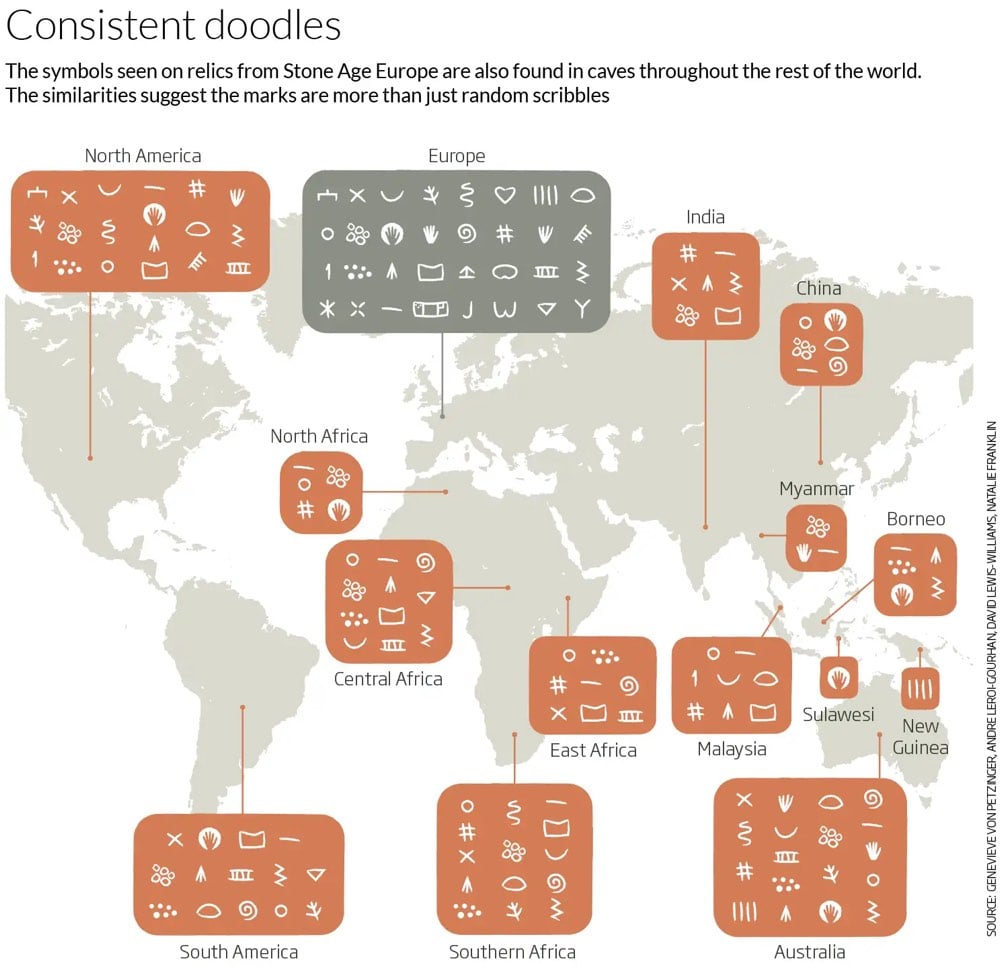
The research also reveals that modern humans were using two-thirds of these signs when they first settled in Europe, which creates another intriguing possibility. “This does not look like the start-up phase of a brand-new invention,” von Petzinger writes in her recently published book, The First Signs: Unlocking the mysteries of the world’s oldest symbols (Simon and Schuster). In other words, when modern humans first started moving into Europe from Africa, they must have brought a mental dictionary of symbols with them.
That fits well with the discovery of a 70,000-year-old block of ochre etched with cross-hatching in Blombos cave in South Africa. And when von Petzinger looked through archaeology papers for mentions or illustrations of symbols in cave art outside Europe, she found that many of her 32 signs were used around the world. There is even tantalising evidence that an earlier human, Homo erectus, deliberately etched a zigzag on a shell on Java some 500,000 years ago. “The ability of humans to produce a system of signs is clearly not something that starts 40,000 years ago. This capacity goes back at least 100,000 years,” says Francesco d’Errico from the University of Bordeaux, France.
Nonetheless, something quite special seems to have happened in ice age Europe. In various caves, von Petzinger frequently found certain symbols used together. For instance, starting 40,000 years ago, hand stencils are often found alongside dots. Later, between 28,000 and 22,000 years ago, they are joined by thumb stencils and finger fluting — parallel lines created by dragging fingers through soft cave deposits.
Von Petzinger lays out the results of her work in a 2016 book called The First Signs: Unlocking the Mysteries of the World’s Oldest Symbols and in a TED Talk from 2015:
It’s not writing (because the symbols don’t appear to be capable of representing the full range of spoken language) and it’s not an alphabet, but it’s definitely an intriguing something. (via open culture)
When They See Us, a Series on the Central Park Five by Ava DuVernay
Ava DuVerney has written and directed a four-part TV series called When They See Us that “chronicles the notorious case of five teenagers of color, labeled the Central Park Five, who were convicted of a rape they did not commit”. Here’s a teaser trailer:
The series starts airing on Netflix on May 31.
And if you haven’t seen it, the documentary The Central Park Five (directed by Ken Burns, Sarah Burns, and David McMahon) is excellent.
Fox News: Unfair and Unbalanced Propaganda
Jane Mayer, author of the very well-reviewed Dark Money: The Hidden History of the Billionaires Behind the Rise of the Radical Right, has a big piece in the New Yorker today on the close relationship between the Trump administration and Fox News.
Hannity was treated in Texas like a member of the Administration because he virtually is one. The same can be said of Fox’s chairman, Rupert Murdoch. Fox has long been a bane of liberals, but in the past two years many people who watch the network closely, including some Fox alumni, say that it has evolved into something that hasn’t existed before in the United States. Nicole Hemmer, an assistant professor of Presidential studies at the University of Virginia’s Miller Center and the author of “Messengers of the Right,” a history of the conservative media’s impact on American politics, says of Fox, “It’s the closest we’ve come to having state TV.”
Hemmer argues that Fox-which, as the most watched cable news network, generates about $2.7 billion a year for its parent company, 21st Century Fox — acts as a force multiplier for Trump, solidifying his hold over the Republican Party and intensifying his support. “Fox is not just taking the temperature of the base — it’s raising the temperature,” she says. “It’s a radicalization model.” For both Trump and Fox, “fear is a business strategy — it keeps people watching.” As the President has been beset by scandals, congressional hearings, and even talk of impeachment, Fox has been both his shield and his sword. The White House and Fox interact so seamlessly that it can be hard to determine, during a particular news cycle, which one is following the other’s lead. All day long, Trump retweets claims made on the network; his press secretary, Sarah Sanders, has largely stopped holding press conferences, but she has made some thirty appearances on such shows as “Fox & Friends” and “Hannity.” Trump, Hemmer says, has “almost become a programmer.”
The subhead of the piece is: “Fox News has always been partisan. But has it become propaganda?” If you’ve been paying attention here over the past couple of years, you know I believe the answer to that question is “yes”. See also Blame Fox News for Fake News, Not Facebook, Study: Watching Fox News Has Big Effect on Voting Patterns, Fox News Is Poisoning America. Rupert Murdoch and His Heirs Should Be Shunned., and Fox News Isn’t A Normal Media Company. We Have To Stop Treating It Like One.
Contemporary Pop Stars on 80s-Style Album Covers
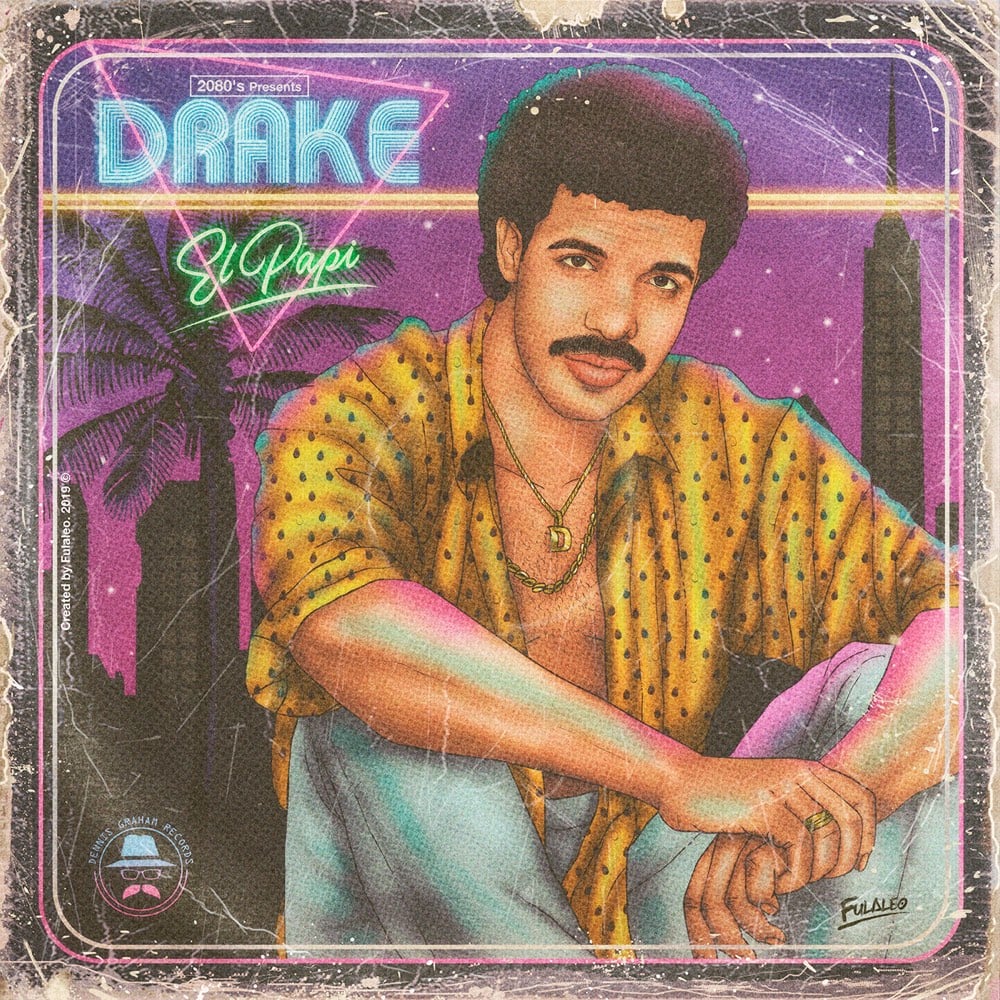

More retro goodness here (including The Weeknd, Skrillex, Taylor Swift, and Cardi B).
De La Soul’s Fight with Tommy Boy Over Copyright and Streaming Revenues

This week, music fans were rejoicing. The legendary hip-hop group De La Soul’s catalog was finally coming to music streaming services. Three Feet High and Rising on Spotify!
Alas, it was too good to be true. It turned out that De La Soul themselves would only be getting 10 percent of the streaming revenue after costs, with label Tommy Boy taking 90 percent.
Now, everyone had speculated that De La Soul’s catalog wasn’t available on streaming because the label had never resolved the legal issues attendant to De La’s innovative use of sampling. The band and label had been sued by The Turtles for their use of a sample in a landmark case that forever changed hip-hop. In 2014, De La Soul gave away free digital copies of their albums to try to get their music to the fans. But now that the albums were to be made available via streaming, everything must have been sorted, right?
Wrong:
This sparked a boycott movement from artists/De La Soul fans like Nas, Pete Rock, and Questlove. Better to avoid Tommy Boy and the new streaming music entirely than put De La Soul in the jackpot for little reward. Tidal also announced that it wouldn’t stream the new album, in respect of the band’s wishes.
On Thursday, Tommy Boy announced that it was delaying the release of the albums on streaming services, likely missing the window for the 30th anniversary of Three Feet High and Rising, but preserving the possibility of a more equitable agreement.
“Because Tommy Boy has not had the opportunity to sit down together with De La Soul and finalize our negotiations — something we’ve wanted to do for months — we have decided to postpone the digital release of their catalog scheduled for tomorrow,” the statement reads. “We know fans are eager to hear these amazing recordings and we are hopeful for a quick resolution.”
A rep for the group did not immediately respond to Variety’s requests for comment.
While a rep for Tommy Boy stressed to Variety that sampling was not a central issue of the disagreement and “negotiating points are still to be finalized,” the group’s catalog with the label has been plagued by legal issues over uncleared samples since shortly after the release of their first album, “3 Feet High and Rising,” some 30 years ago. That album — widely considered to be one of the best and most influential hip-hop albums ever released — and several other titles from the group never have been legally available on streaming services, as the catalog has moved from Tommy Boy to Warner Bros. and back again without the sampling issues being resolved.
On Friday, De La Soul gave a lengthy interview to Billboard where they spoke on these issues, and their hope that they might be resolved:
“It’s a victory,” Pos, of De La Soul, tells Billboard. “It’s great that people who supported and understood what we mean to the culture, whether it’s someone who’s so dear and close to us like a Q-Tip, or someone who could admire the moves we’ve made creatively, but we ain’t necessarily been in the room with each other nothing but maybe three times together, like a Jay-Z. You can have people just feel like, ‘Culturally, I support and understand where they are coming from.’” …
“He [Tommy Boy’s Tom Silverman] can legally do what he wants, but the issues that I raised [was that] in all that you’re doing with what you’re able to do, did you clear it? Did you clear those samples? When he got the catalog back, is it cleared? What he said on the phone was, ‘If anything comes up, we will deal with it the way we’ve dealt with it in the past.’ And what I know that to be is that if a lawsuit comes up, we’re gonna settle because we’re in the wrong. I say we because we do suffer from that.”
As De La Soul’s Mase told Variety, the band has never earned money from its recorded catalog because of the levies the original copyright owners have placed on the band’s samples. “Let’s be straight up: We don’t really financially benefit — there’s so many infractions around this whole thing that we’ll probably never see no money from it or any project that has these infractions.”
It’s a shame, because De La Soul created some of the most exciting—and original music of the late 1980s and early 1990s. Let’s hope that the band and label can come to an agreement, the samples can be properly cleared, and we can hear these albums on whatever service we want (with the band finally getting their fair share) soon.
The European Parenthesis

There’s an idea in media history and media theory called “The Gutenberg Parenthesis.” The basic idea of it is simple: the dominance of fixed, printed text is a historical blip in a broader history of much more mutable, orally-driven media forms. You find versions of this idea in Walter Ong and Marshall McLuhan, but it’s being re-thought for digital technology by folks like L.O. Sauerberg and Thomas Pettit. And one of the implications is that if you want to understand media today, you have to understand media before Gutenberg and print. The future is medieval, is one formulation of this.
A similar idea can be applied to world history, and it has been by J.C. Sharman in his book Empires of the Weak: The Real Story of European Expansion and the Creation of the New World Order. Here the focus isn’t print technology, which Europe borrowed and adapted from Asia 500 years ago, but European domination of the rest of the world, which, Sharman contends, really only got going a little more than 200 years ago and is questionable today.
This is from a review of Sharman’s book by Alan Mikhail, titled “When Asia Ruled the World”:
In Sharman’s account, the dominance of the West (note Europe’s easy baton-pass to the United States), roughly from the Enlightenment to World War II, represents a historical blip in the last millennium. And, perhaps more important, today we seem to be on the cusp of a return to a more regular state of affairs, where the large states of Asia will again be the globe’s hegemons.
To make this provocative argument, Sharman finds the early modern period, conventionally dated from 1500 to 1800, the most fruitful for thinking about where we are headed. In those centuries, the enormous empires of the East — the Qing, the Ottomans and the Mughals — were the most formidable states on earth. Territory equaled power, and those states held the most land…
Asia’s enormous land-based empires didn’t much care about their coastlines and tolerated — more than they succumbed to — the Europeans nibbling on their shores in what were desperate, highly risky and ultimately temporary ventures. Until approximately 1750, Europeans — even in Europe, thanks to the Ottomans — held no military advantage over other powers.
But how then to explain the undeniable fact that Europeans dominated the globe from the turn of the 19th century to World War I? Sharman reasons that it was a combination of internal fractures within the Qing and Ottoman Empires, as well as the inclination of Europeans to think that empire building was the route to national sovereignty: in other words, almost a kind of vanity project.
The future, contends Sharman, is medieval; one in which Asia dominates the planet, and Europe and the West are at the periphery of global power and influence. There’s a lot that’s going to change over the next century; global climate change is certainly going to shift the balance of power and the fight for survival worldwide. But the idea that we’re coming out of a historical aberration rather than a necessary outcome is well worth thinking about.
Tupac Shakur’s Break-Up Letter to Madonna
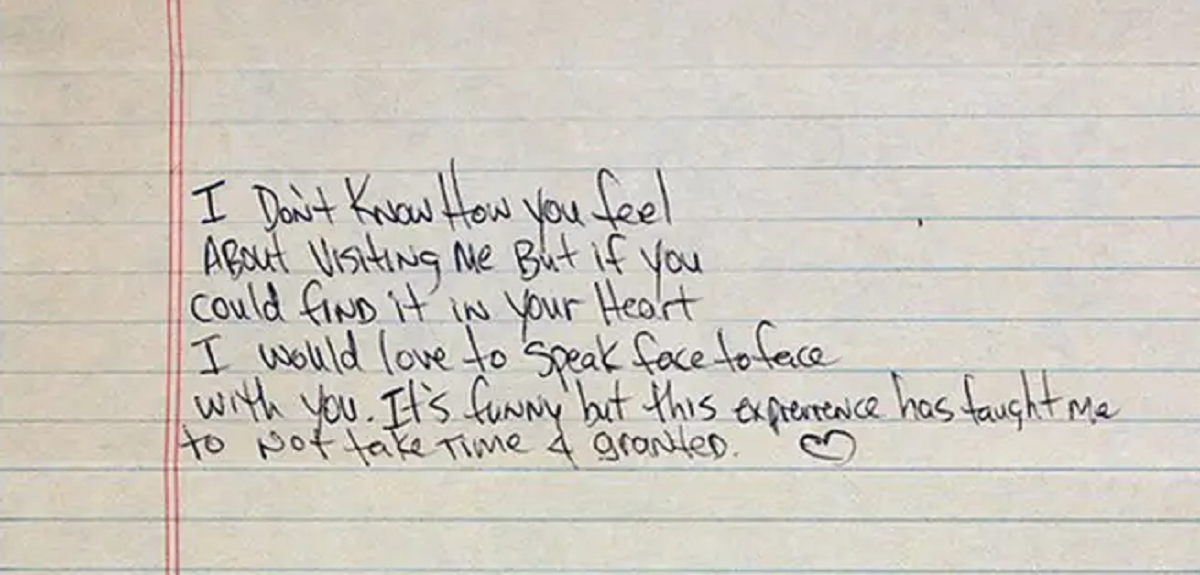
Tupac Shakur and Madonna dated briefly in 1994. According to Tupac’s brother Mopreme, the relationship began when Madonna passed Tupac a note during a press day for Above the Rim. The two of them broke up sometime before Tupac was shot on November 30, 1994 as part of a robbery at the Quad Recording Studios in Manhattan. Shortly after he was shot, Tupac was convicted of three counts of molestation as part of a sexual abuse case brought against him in 1993.
While in jail, Tupac wrote a letter to Madonna. This letter appears to have been sold at auction by Madonna’s former friend, art dealer Darlene Lutz, in 2018, after Madonna lost a legal fight to have it returned to her and keep it from being sold. Exactly what became of the letter is unknown.
It’s a remarkable letter, although parts of it have been blurred out by the auction house. The Independent focuses on the fact that Tupac was concerned about being seen publicly dating a white woman:
Can u understand that? For you to be seen with a black man wouldn’t in any way jeopardise your career. If anything it would make you seem that much more open & exciting. But for me at least in my previous perception, I felt due to my ‘image’ I would be letting down half of the people who made me what I thought I was. I never meant to hurt you.
Tupac was also upset by an interview that Madonna gave where she said, “I’m off to rehabilitate all the rappers and basketball players.”
“Those words cut me deep seeing how I had never known you to be with any rappers besides myself,” Tupac writes in the letter. “It was at this moment out of hurt & a natural instinct to strike back and defend my heart & ego that I said a lot of things.”
In her note on the letter, “Please Do Say Forgive Me,” Chandra Steele focuses instead on the nature and quality of Tupac’s apology.
Celebrities are separated from us by our perception of their godlike attainment of what we’re supposed to want: fame and money and sex. But when Tupac refers to their relationship, he uses words of humanity and humility. “I haven’t been the kind of friend I know I am capable of being” is how he frames the apology. It’s an empathy that some never access within themselves, no matter how many classes they take in unlocking their chakras. Later he tells Madonna, “I offer my friendship once again, this time much stronger and focused.” …
What’s more remarkable than what’s written is what isn’t. Tupac does not overstep the bounds of being an ex-lover. He does not push a selfish agenda. He has the wisdom to balance what he wants with what is warranted after leaving sans explanation. He does not burden her by asking for her forgiveness.
And then there are Tupac’s closing words:
I Don’t Know How you feel
About visiting me But if you
could find it in your Heart
I would love to speak face to face
with you. It’s funny but this experience has taught me
to Not take time 4 granted. [heart]
The Heart of the Grand Canyon Map
Over a period of 8 years, explorer and photographer Bradford Washburn worked with a small team and National Geographic to produce a map called The Heart of the Grand Canyon. Published in 1978, it is “still considered by many to be the most beautiful map of the area ever created”.

Here’s a closeup view of part of the map, which shows just how much detail is there:

Often Washburn was dropped off on top of a pinnacle or small butte along with surveying equipment, such as a state-of-the-art laser range-finder device still under development, on loan from the company that made it. Using a built-in telescope, Washburn would aim the helium-neon laser at a reflecting prism positioned on another point miles away. The laser beam would be reflected back to the range finder, which measured how long the beam’s round-trip took and translated that into distances that were accurate to within 6/100 of an inch per mile. Washburn used a 40-pound surveying instrument called a theodolite to measure the angles between each of the control points, providing him with the relative position and height of each set of points.
After a few weeks in the canyon, Washburn was convinced of the potential for “a map of really superlative beauty as well as topographic quality.” Knowing exactly where to find the expertise, and the funds, needed to realize that potential, he asked the National Geographic Society to join the project.
The surveying took years and then came the data analysis & production phases…it took over 1000 hours just to paint the relief shading onto the map. If you want to compare Washburn’s map to earlier efforts, check out this post at Codex 99. This 1903 USGS map was the best map into the 1960s:

Even in the age of crisp satellite views in Google Maps, The Heart of the Grand Canyon is a beautiful and useful map. You can purchase a copy of the 1978 map (and a refreshed 1999 version) from the National Geographic store.
Mapping the Odyssey Isn’t Easy

We’ve looked before at maps of Odysseus’s travels in The Odyssey (as Jason wrote in 2018, “that dude was LOST”). But it turns out — and maybe this shouldn’t be surprising — that it’s not easy to figure out exactly where Odysseus was in the Mediterranean Sea for all that time.
Scholars have pored over the text for clues for centuries, argued about their findings, and tried to interpret ambiguous language. We don’t even know for certain where Odysseus’s home island of Ithaca was.
Ithaca is one of a group of four islands, with smaller islands nearby, but it faces west while the others face east. (What does it mean for an island to face a direction?) It has forests and at least one mountain, and it is a good place for raising children. That isn’t much to go on.
Then there’s the whole question of what we gain from mapping The Odyssey in detail anyways. Some of it is plugging a gap in our imagination; we’ve gotten used to fantasy worlds supplying us with maps, and The Odyssey is a fantasy world that coexists with our own. But the level of detail is obsessive.
Attempts to map the Odyssey seem different from other attempts to locate the sites of famous myths and legends. Atlantis was the site of a wondrous civilization, Troy the landscape for an epic battle; finding them in the real world would mean discovering rich sources of evidence about past cultures. El Dorado’s location seems to have been coveted mainly for the lost city’s purported riches, Bimini for its rumored fountain of youth. But what do we gain by knowing where Helios kept his cows? Or which rocky, uninhabitable cave a kidnapping nymph called home?
Nevertheless, there’s a long history of scholars, artists, kings, and more attempting to write themselves into the myth of The Odyssey. The Aeneid, which simultaneously reimagines the founding of Rome as part of the story of the Iliad and Odyssey and elevates Virgil’s Latin poetry to the epic heights of Homer, is the most famous attempt to shore up a claim to legitimacy by appealing to the reality of the Odyssey’s ancient past.
But where exactly was Odysseus? Was he mostly in the Aegean and Italy, as Abraham Ortelius believed in 1597? Or was he scattered into the western Mediterranean, Spain, Corsica, North Africa, as Peter Struck thinks? We’ll probably never know. That dude was LOST.





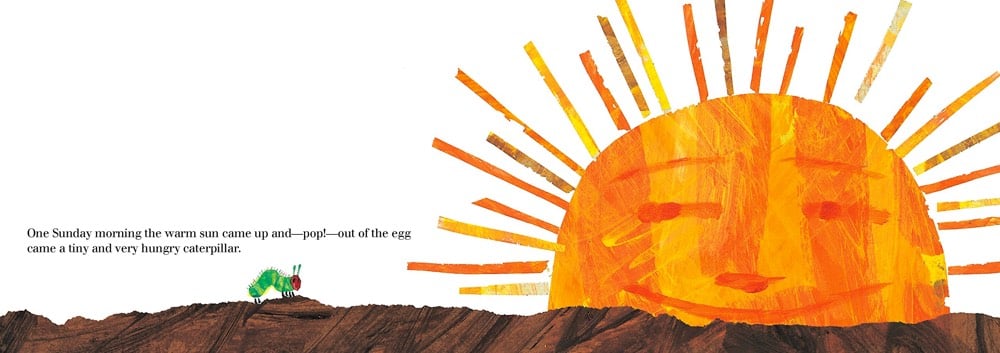
Stay Connected